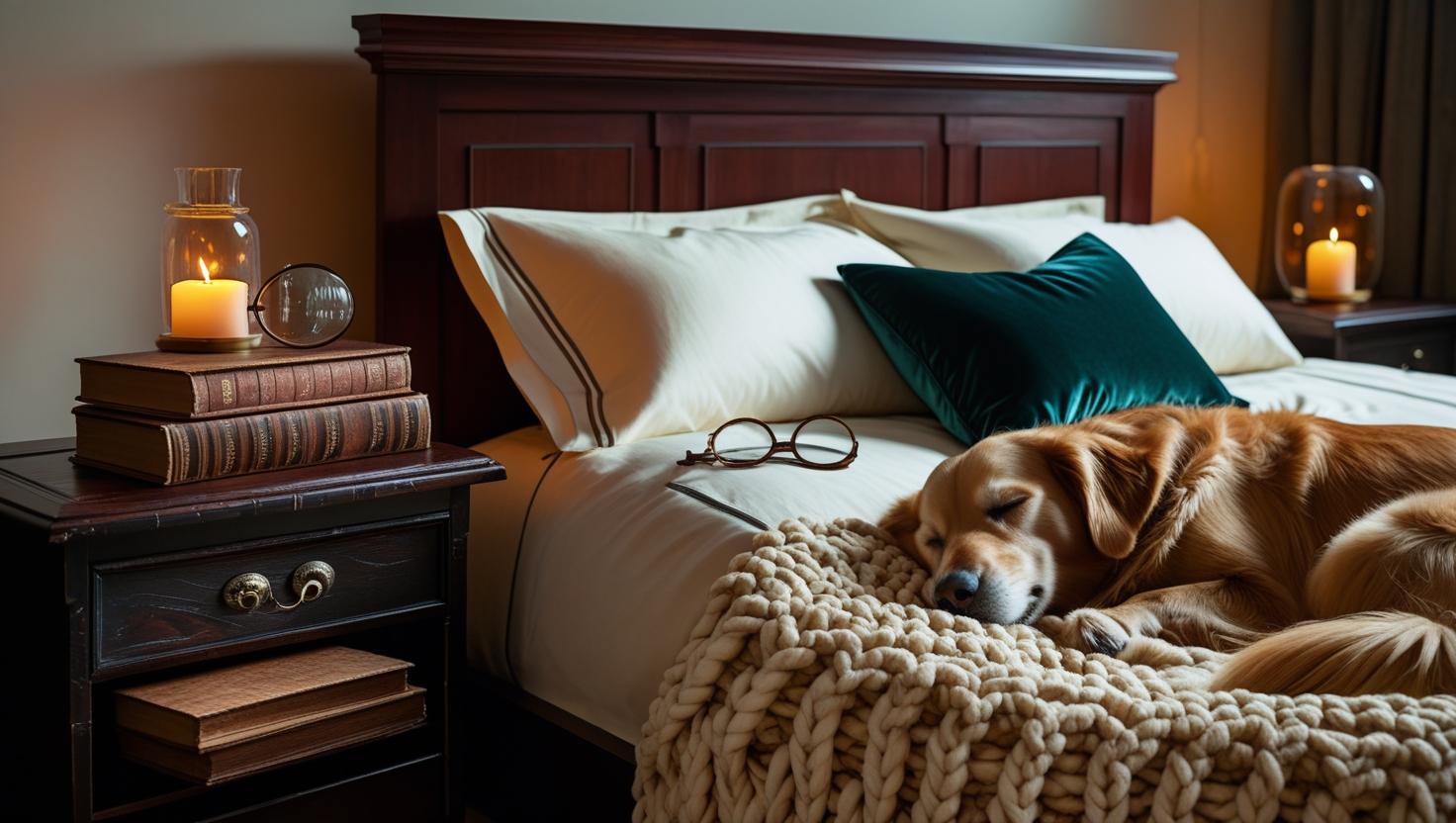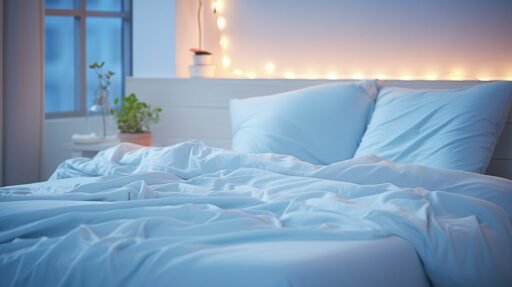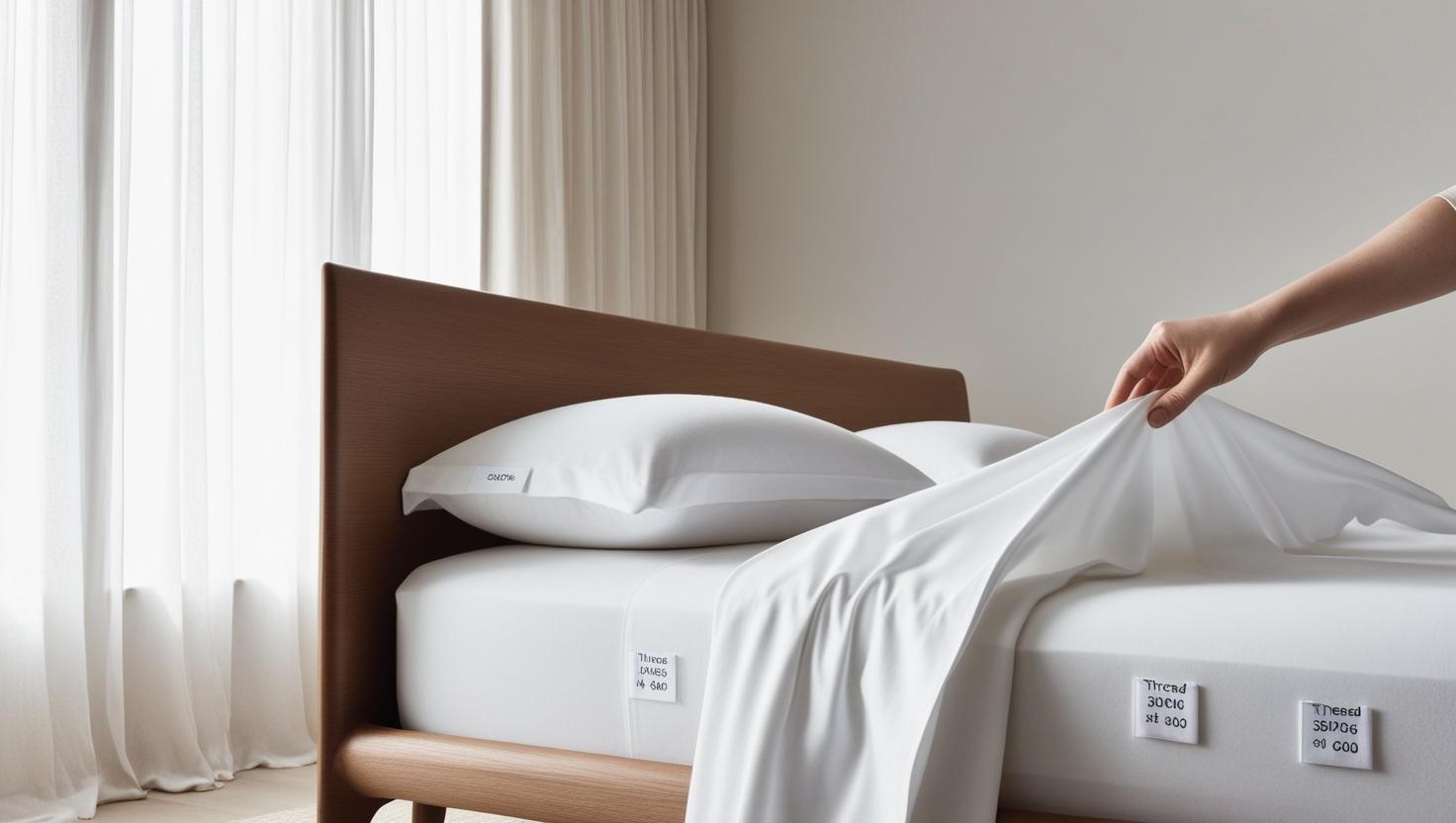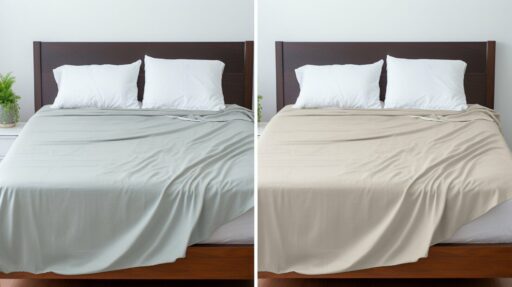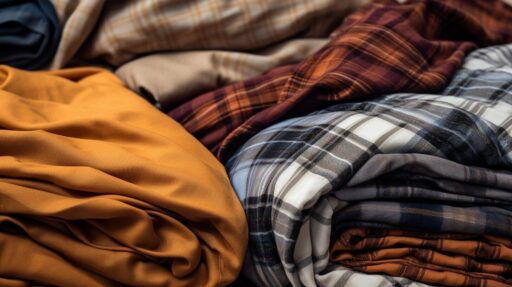Unveiling the unique story of traditional bed frames, this article offers a profound exploration into their history and evolution. You’ll trace back to the roots of this staple furniture piece, discov…
Continue readingTemperature-Regulating Bedding: Sleeping Cool and Comfortable
Temperature-Regulating Bedding: Best Sheets to Stay Cool in 2025
Tired of waking up drenched in sweat? Temperature-regulating bedding keeps you cool, dry, and comfy all night. Discover the best sheets for hot sleepers and tips to choose your perfect set.
Key Takeaways
- Temperature-regulating bedding improves sleep by managing heat and moisture.
- Bamboo, linen, and eucalyptus fabrics offer superior cooling properties.
- Not all high-thread-count sheets are cooling—opt for breathable weaves instead.
Why Temperature-Regulating Bedding Matters
Good sleep starts with the right temperature. Bedding that regulates heat and moisture can prevent overheating, improve comfort, and help you fall asleep faster and stay asleep longer. It’s especially essential for hot sleepers or those experiencing night sweats.
Top Temperature-Regulating Sheets for 2025

Luxome Luxury Sheet Set
These bamboo-derived sheets are breathable, moisture-wicking, and incredibly soft. The Luxome Luxury Sheet Set is a top-tier pick for those wanting cloud-like comfort and year-round temperature control.
Silk & Snow Percale Sheets
For a crisp, affordable option, Silk & Snow’s Percale Sheets offer great airflow and cooling. Their percale weave keeps things light and breathable without the steep price tag.
Hush Iced Cooling Sheet Set
The Hush Iced Cooling Sheets are beloved for their silky feel and cooling effect. They’re perfect for sleepers who love ultra-soft sheets with advanced heat-wicking tech.
More Cool Contenders
- Sweet Zzz Organic Bamboo Sheets: Eco-friendly and perfect for sweaty sleepers.
- Brooklyn Bedding Tencel Sheets: Deep-pocket fit, naturally cool.
- Quince Bamboo Sheet Set: Affordable and sustainable cooling comfort.
- Cozy Earth Bamboo Sheets: Loved by Oprah for luxury cooling.
- Brooklinen Luxe Core Sheets: Breathable with a sleek look.
- Sijo AiryWeight Eucalyptus Sheets: Ultra-light and moisture-wicking.
- Boll & Branch Signature Sheets: Soft and breathable all-season favorite.
- Nollapelli Signature Sheets: Spa-level comfort at home.
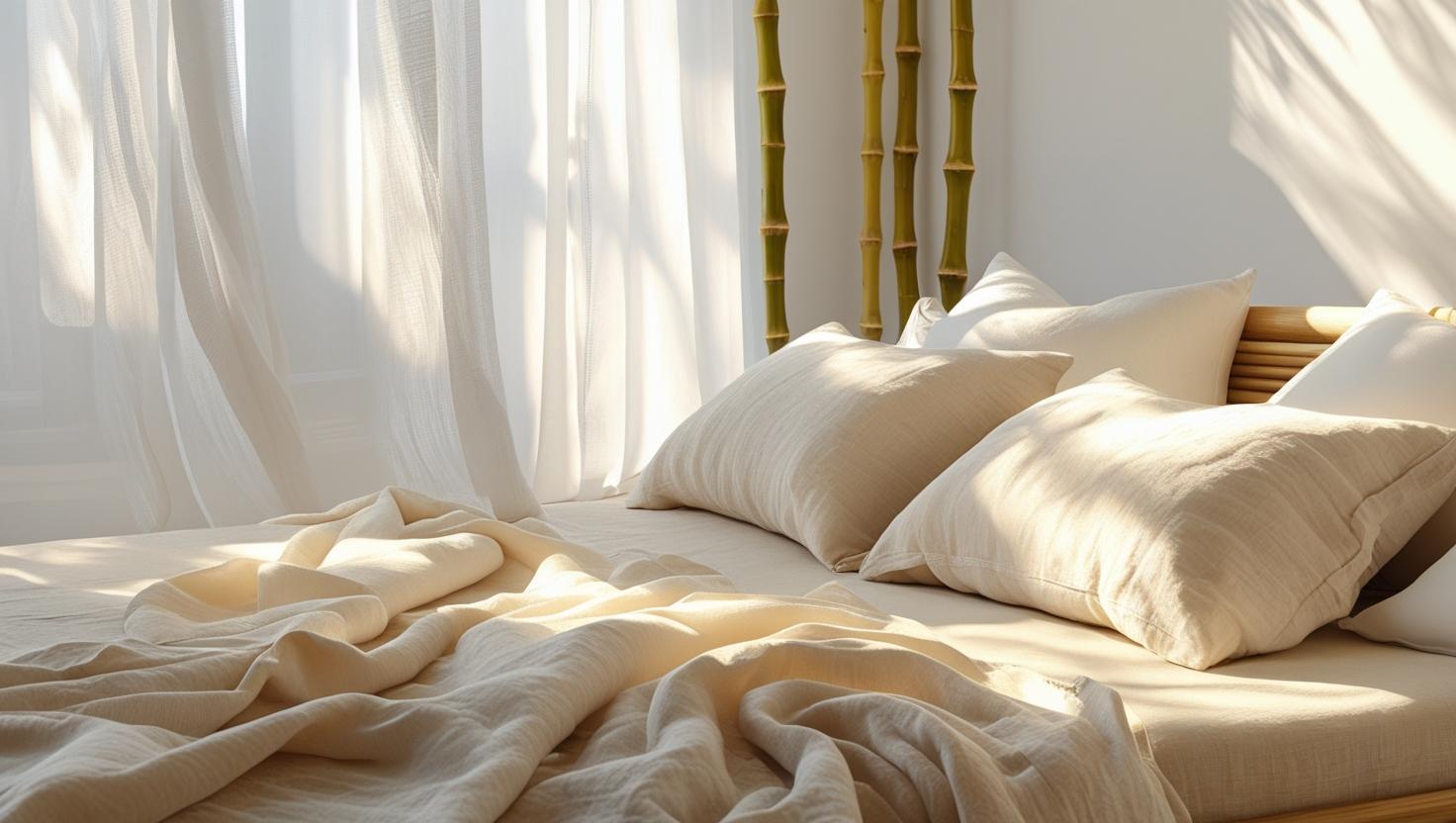
What to Look for in Cooling Bedding
Material Matters
Look for natural fibers like bamboo viscose, cotton, linen, or eucalyptus. These materials offer excellent moisture management and breathability.
Weave Wonders
Percale weaves are light and crisp, making them ideal for airflow. Sateen is smoother but tends to retain a bit more heat—better suited for cooler months.
Thread Count Truth
Don’t fall for the myth that higher is always better. For breathable bedding, a thread count between 200–400 is optimal for air circulation and softness.
Cooling Doesn’t Mean Cold
Temperature-regulating bedding balances body heat without making you feel chilly. It keeps you comfortable—never too hot, never too cold.
Extra Cozy Picks
- Saatva Linen Sheet Set: Stylish, breathable, and ideal for warm sleepers.
- Parachute Percale Sheets: Durable and smooth with excellent airflow.
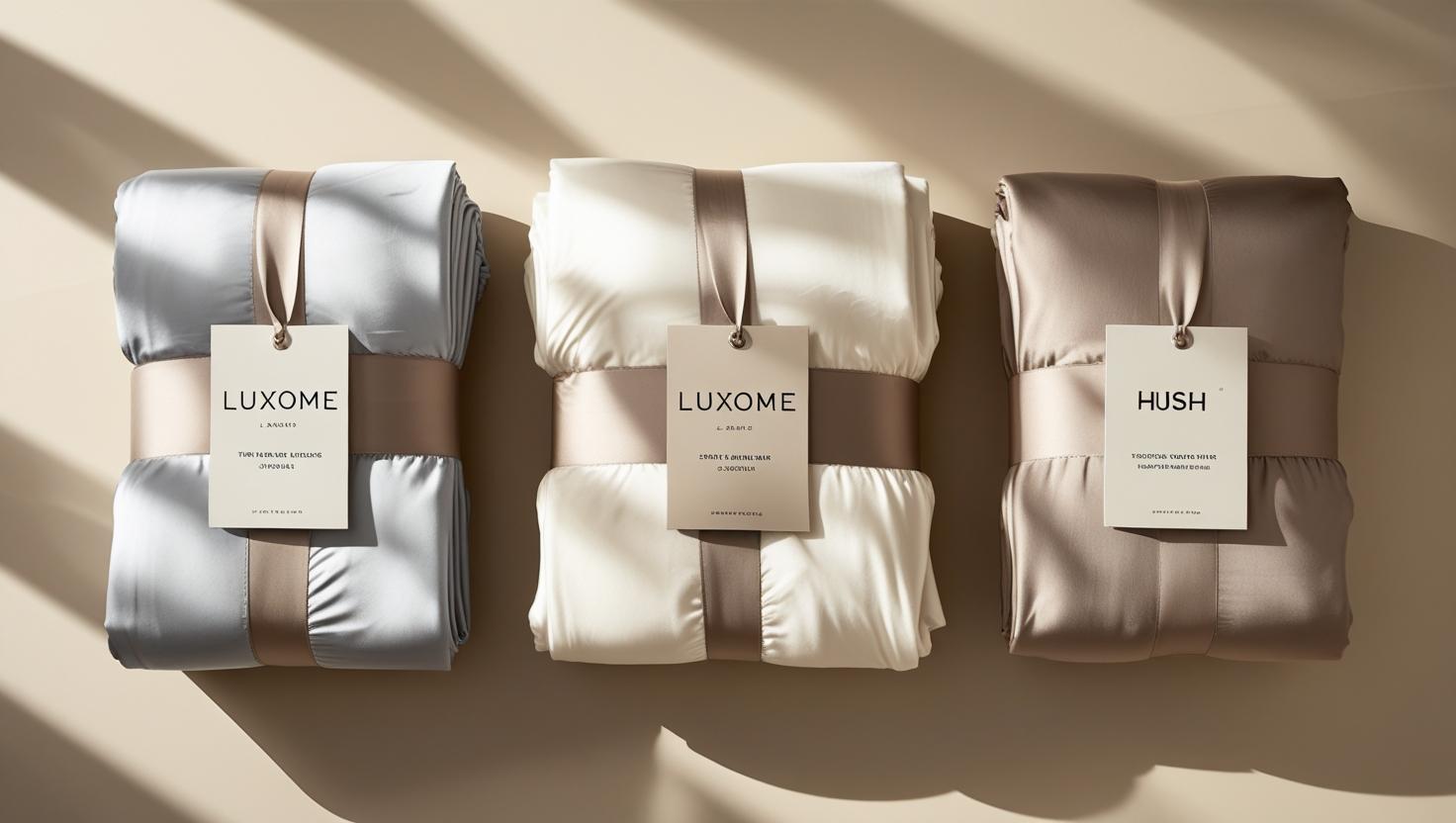
Real-Life Scenario: Imagine This…
You slip into bed after a sweltering summer day. Your sheets feel fresh, breathable, and cool. No sweat. No tossing. Just effortless, uninterrupted sleep. That’s the magic of the right bedding.
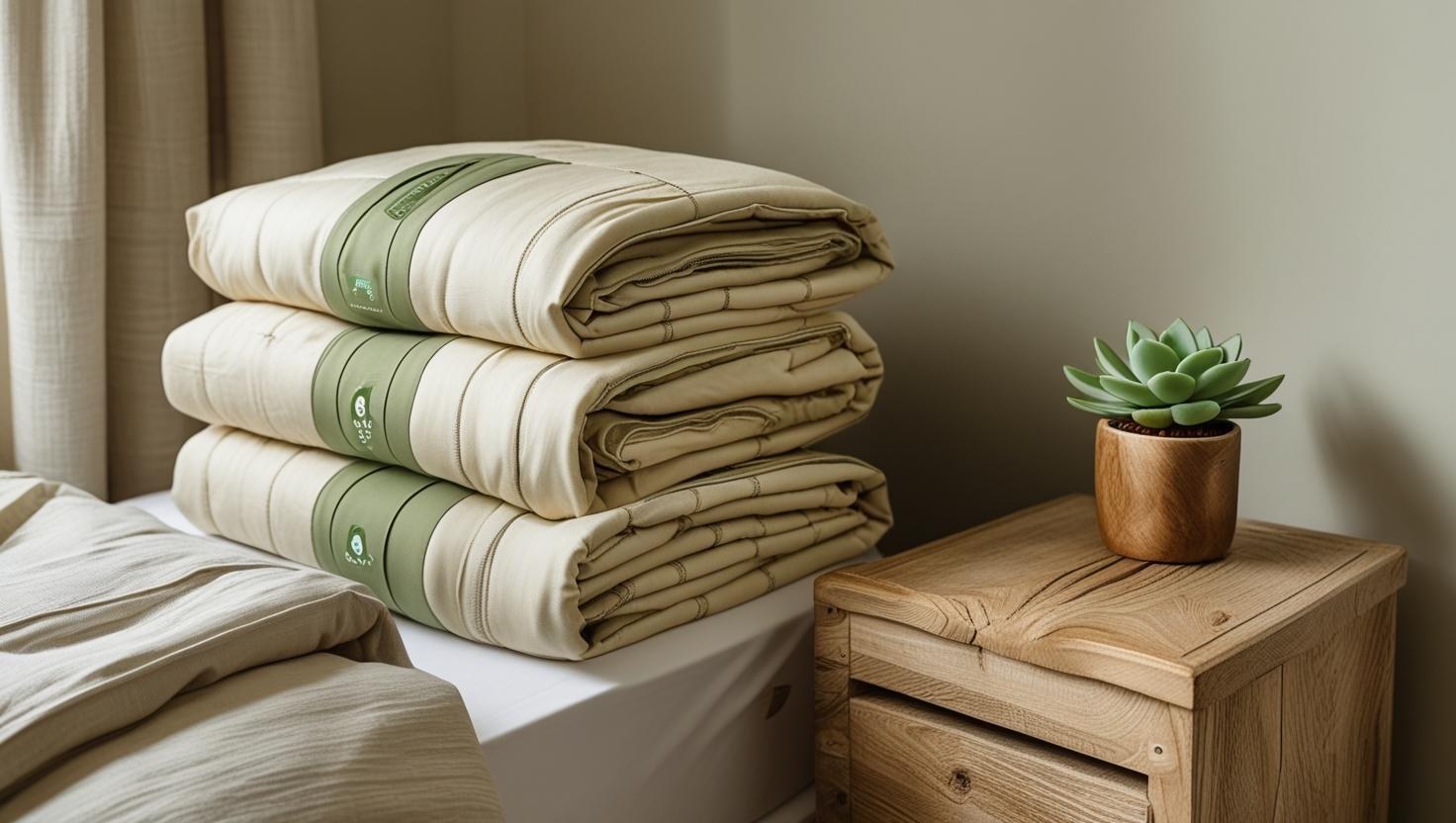
FAQ
- What is temperature-regulating bedding?
- Temperature-regulating bedding uses breathable materials to manage body heat and moisture, keeping you cool and dry while you sleep.
- Are bamboo sheets better for hot sleepers?
- Yes, bamboo sheets are highly breathable and moisture-wicking, making them an excellent choice for people who sleep hot or sweat at night.
- Do cooling sheets really work?
- Yes. Cooling sheets made from materials like bamboo, Tencel, or eucalyptus are designed to improve airflow and pull heat away from the body.
Final Thoughts: Sleep Cooler, Sleep Better
Investing in temperature-regulating bedding is one of the easiest ways to improve your sleep. Whether you’re battling hot summer nights or dealing with night sweats, the right sheets can make all the difference. Explore more of our top picks and stay comfy year-round.
Check out our related guides like Best Mattress for Hot Sleepers or How to Regulate Sleep Temperature.
Mattress Toppers Explained: Best Types, Benefits & Buying Tips
Mattress Toppers: Types, Benefits & How to Choose<
If your bed feels too firm, too soft, or just tired, mattress toppers offer a fast, affordable fix.
Choose the right material (memory foam, latex, wool, down/alternative), match thickness to your needs (1–4″), and pick cooling options if you sleep hot.
In minutes, you can add pressure relief, better temperature regulation, and a fresh feel—without buying a new mattress.
Key Takeaways on Mattress Toppers
- Match feel to position: side sleepers usually prefer softer toppers; back/stomach sleepers do better with medium–firm support.
- Thickness matters: 3–4″ revives a worn bed; 1–2″ adds a gentle comfort boost.
- Stay cool: look for gel-infused memory foam, breathable latex, or moisture‑regulating wool if you’re a hot sleeper.
- Allergy‑friendly: latex, wool, and down alternatives are top picks for sensitive sleepers.
- Budget win: mattress toppers extend mattress life and upgrade comfort for far less than a replacement.
Ever wake up feeling like your bed just isn’t cutting it anymore? Before splurging on a new mattress, consider this simpler solution.
Why Opt for a Mattress Topper?
A topper adds comfort, support, and temperature control—instantly upgrading how your mattress feels.
A bed topper is like a mini upgrade for your mattress. It adds comfort, support, and helps regulate your body temperature as you sleep. Whether your current bed is too firm or just a bit tired, the right sleep surface addition can breathe new life into it.
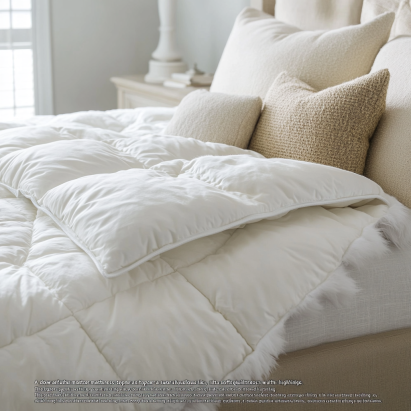
Popular Materials for Bed Toppers
Pick your feel and performance: contouring foam, bouncy latex, plush down/alternative, or breathable wool.
- Memory Foam
- Contours to your body for personalized support. Great for pressure relief and motion isolation—ideal for restless sleepers or couples.
- Latex
- Responsive and naturally hypoallergenic. It offers bounce and breathability, and it’s perfect for hot sleepers.
- Down and Feathers
- Light, fluffy, and luxurious. These comfort layers add a cozy, cloud-like feel to any bed, especially in colder seasons.
- Down Alternatives
- Soft and plush, but made with synthetic fibers—ideal if you have allergies or want an animal-friendly option.
- Wool
- Wicks away moisture and keeps your body temperature steady, making it a great pick year-round.
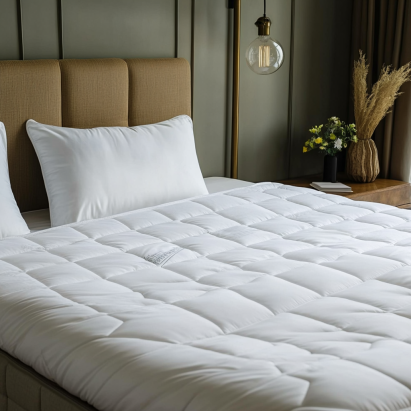
Choosing the Right Bed Topper
Start with sleep position, then choose thickness, cooling, and allergy‑friendly materials.
1. Firmness
Softer for side sleepers, firmer for back and stomach sleepers.
- Side sleepers often love softer layers for cushioning shoulders and hips, while back or stomach sleepers tend to benefit from firmer support.
2. Thickness
Use 3–4″ to revive a tired bed; 1–2″ for a gentle comfort boost.
- Go for 3–4 inches if your mattress needs serious help. If it just needs a little comfort boost, 1–2 inches will do.
3. Temperature Regulation
Choose gel‑foam, latex, or wool for better airflow and cooling.
- Hot sleepers, look for gel-infused memory foam, latex, or wool for better airflow and cooling comfort.
4. Allergies
Prioritize hypoallergenic picks like latex, wool, or down alternative.
- If you suffer from allergies, stick with hypoallergenic materials like latex, down alternatives, or wool.
Top Comfort Layer Recommendations
These well‑reviewed options balance comfort, support, and cooling across budgets.
- Saatva Graphite Memory Foam Mattress Topper
- Infused with graphite for cooling and contouring support.
- Silk & Snow Organic Mattress Topper
- Made from organic cotton and gel foam—sustainable, soft, and breathable.
- Brooklyn Bedding Memory Foam Topper
- Known for contouring and cool sleep with breathable design.
- Sleep Is the Foundation Cooling Memory Foam Topper
- Great for hot sleepers who need both temperature control and support.
- PlushBeds Natural Latex Topper
- Eco-friendly, supportive, and naturally hypoallergenic.
Price Comparison Table
| Product | Material | Features | Price |
|---|---|---|---|
| Saatva Graphite Memory Foam | Graphite-Infused Memory Foam | Cooling, pressure relief | $299 |
| Silk & Snow Organic | Organic Cotton, Gel Foam | Eco-friendly, breathable | $399 |
| Brooklyn Bedding | Memory Foam | Contouring, airflow | $199 |
| Sleep Is the Foundation | Cooling Gel Foam | Temperature regulation, support | $349 |
| PlushBeds Natural Latex | Natural Latex | Durable, hypoallergenic | $499 |
Why People Love Bed Toppers
They relieve pressure, help you sleep cooler, and refresh your bed for less.
- Pressure Relief: They cushion your body and ease stress on pressure points.
- Cooler Sleep: With the right materials, you’ll stay comfortable through the night.
- More Comfort: Instantly change the feel of your bed—firmer, softer, you name it.
- Mattress Protection: Extend your mattress’s life by adding a protective layer.
- Budget-Friendly Upgrade: A smart way to improve sleep without buying a new mattress.
![A latex mattress topper on a bed in a minimalist bedroom with natural light streaming through sheer curtains.]](https://cozybedquarters.com/wp-content/uploads/2023/10/Mattress-Topper-2.webp)
Luxury Sleep Surface Enhancers: Because You Deserve It
Premium toppers add organic fabrics, zoned support, and high‑end cooling for hotel‑level comfort.
- Organic and natural materials
- Advanced cooling features
- Long-lasting craftsmanship
FAQ
- Do mattress toppers really make a difference?
- Yes—adding the right topper can improve pressure relief, adjust firmness, and enhance cooling, often extending the life of your mattress.
- What thickness mattress topper should I get?
- Choose 1–2″ for a light comfort boost and 3–4″ to revive a too‑firm or aging mattress.
- Which material sleeps the coolest?
- Latex and wool are naturally breathable; gel‑infused memory foam can also help with heat management.
- Will a topper fix a sagging mattress?
- It can mask mild wear, but deep sags usually require a new mattress or warranty claim.
- Are mattress toppers good for allergies?
- Latex, wool, and down alternative toppers are typically better for allergy‑prone sleepers.
Conclusion
Your bed should be a haven, and a thoughtfully chosen topper is one of the easiest ways to make it feel like one. Whether you’re after firm support, gentle cushioning, or cooling comfort, there’s a perfect match out there. So go ahead—treat yourself to better sleep tonight.
Looking for more ways to elevate your rest? Visit our sleep accessory guide for inspiration!
Related reading from Cozy Bed Quarters
- Bedding Accessories Pillows Toppers: 7 Must-Have Picks for Dreamy Sleep
- Enhance Your Sleep with the Right Mattress Toppers
- 7 Powerful Ways to Clean Pee Mattress No Baking Soda
Other reading we found popular
- Sleep Foundation — Best Mattress Toppers
- The Spruce — Best Mattress Toppers
- Architectural Digest — Best Mattress Toppers
Navigating the World of Organic and Eco-Friendly Mattresses
Organic and Eco-Friendly Mattresses: 7 Proven Benefits
Meta description: Organic and Eco-Friendly Mattresses deliver safer, cooler sleep with certified materials like latex, cotton, and wool—cutting VOCs and shrinking your footprint.
Quick answer: Organic and Eco-Friendly Mattresses replace petro-foams and harsh chemicals with certified natural materials—like organic latex, cotton, and wool—so you breathe fewer VOCs, sleep cooler, and reduce your footprint without losing comfort. Look for GOLS/GOTS, OEKO-TEX, USDA, or CertiPUR-US labels for verified safety and sustainability.
Key Takeaways
- Prioritize certifications: GOLS/GOTS, OEKO-TEX, USDA, and CertiPUR-US verify organic inputs and low emissions.
- Materials matter: Natural latex, organic cotton, Tencel, and wool improve breathability, temperature control, and durability.
- Healthier for you: Fewer VOCs and flame-retardant chemicals on most certified models.
- Comfort without compromise: Latex and hybrid builds offer contouring pressure relief with sturdy support.
- Complete the setup: Pair with a sustainable wood bed frame to finish your eco upgrade.

At a glance: what to look for in organic and eco-friendly mattresses.
Welcome to the world of organic and eco-friendly mattresses, where comfort and sustainability meet. With so many choices, picking the perfect bed can feel overwhelming—this guide makes it simple.
Popular organic and eco-forward brands include Birch, Eco Terra, Saatva, Nolah, PlushBeds, WinkBeds, Silk & Snow, Latex for Less, Plank, Spindle, and My Green Mattress.
Why Choose Organic and Eco-Friendly Mattresses?
Choose organic and eco-friendly mattresses to lower chemical exposure, sleep cooler, and reduce your environmental footprint—without giving up comfort or support.
These beds replace high-VOC foams and chemical flame barriers with natural latex, wool, and cotton. The result: a cleaner sleep surface and materials sourced with lower environmental impact.
Mini-scenario: If you’re sensitive to odors, a latex-and-wool hybrid with GOTS/GOLS certifications can minimize off-gassing during the first nights.
Materials That Make a Difference
Materials drive feel, durability, and temperature. Here’s what to expect:
- Organic latex: Buoyant, pressure-relieving, and long-lasting. Great for back and combo sleepers.
- Organic cotton: Breathable covers and batting that wick moisture without synthetics.
- Wool: Natural temperature and moisture regulator; often used as a flame barrier.
- Tencel/lyocell: Silky plant-based fibers that cool and soften the surface.
- Recycled steel coils: Zoned support and airflow in eco-focused hybrids.
Mini-scenario: Hot sleeper? A latex hybrid with a breathable cotton cover and wool layer often sleeps cooler than dense polyurethane foam.
Learn more about mattress materials and types if you’re comparing foam vs. latex vs. hybrid builds.
Certifications: What Each Label Really Means
Trust—but verify. Look for these third-party standards when you shop:
- GOLS (latex) / GOTS (textiles): Confirms organic sourcing and responsible processing for latex, cotton, and wool.
- USDA Organic: Validates agricultural inputs grown without most synthetic pesticides or GMOs.
- OEKO-TEX Standard 100: Tests finished textiles for harmful substances.
- CertiPUR-US (polyfoam): Ensures foam is made without certain harmful chemicals and meets low-emission criteria.
For deeper background, see the Non-Toxic Mattress 2025 guide and the National Sleep Foundation resources on safer sleep environments.

Labels to look for when comparing organic and eco mattress options.
Comfort & Performance: How They Sleep
Latex responds quickly and supports neutral spinal alignment, while wool and cotton manage moisture for a drier, cooler feel.
- Pressure relief: Latex contours without the slow “sink” of memory foam.
- Motion isolation: Latex comfort layers and pocketed coils limit partner transfer.
- Edge support: Reinforced coils or firmer latex rails help if you sit or sleep near the edge.
Mini-scenario: Side sleeper with shoulder pressure? Choose a medium model with plush latex on top and zoned coils beneath.
Cost, Value & Longevity
Organic models often cost more upfront but can last longer—especially latex builds, which resist sagging.
- Best value: Start with a latex hybrid; it balances price, airflow, and support.
- Warranty & trials: Look for at least a 10–25-year warranty and 100-night or longer trials.
- Total upgrade: Pair your mattress with a sustainable wood bed frame to avoid particleboard and added resins.
Mini-scenario: Budget-minded? A thinner latex hybrid can deliver certified materials at a lower price than all-latex designs.
Organic vs. Conventional: Quick Compare
- Materials: Organic uses latex, cotton, wool; conventional relies on polyurethane foams and synthetic blends.
- Emissions: Certifications aim to limit VOCs; conventional beds may off-gas more.
- Temperature: Latex and wool breathe; dense foams can trap heat.
- Durability: Latex resists impressions; lower-density foams may compress faster.
Explore our broader primer on green mattresses and eco-friendly sleep to see how the rest of your bedroom impacts air quality.
How to Shop: A Simple Checklist
Use this 5-step process to buy with confidence:
- Set your feel: Choose plush for side sleepers, medium for combo, firm for back/stomach.
- Verify labels: Confirm GOLS/GOTS, OEKO-TEX, USDA, or CertiPUR-US on the product page.
- Check construction: Prefer breathable covers, wool fire barriers, and pocketed coils for airflow.
- Review policies: Look for 100-night+ trials, free returns, and robust warranties.
- Finish the ecosystem: Add breathable sheets and a nontoxic frame; see our eco-friendly bedding options.
Authority and certification resources: American Academy of Sleep Medicine and CertiPUR-US consumer guidance.

A cohesive eco bedroom pairs an organic mattress with a sustainable frame.
Conclusion: Make the Switch to Organic and Eco-Friendly Mattresses
Switching to organic and eco-friendly mattresses delivers cleaner materials, lasting comfort, and a lighter footprint—an upgrade you’ll feel every night. For more guides and comparisons, explore Cozy Bed Quarters.

Your bed, but better for you—and for the planet.
FAQ
What makes a mattress organic or eco-friendly?
Third-party certifications and materials. Look for GOLS/GOTS for organics, OEKO-TEX for substance testing, USDA for organic inputs, and CertiPUR-US for foam safety.
Are organic mattresses firmer than regular beds?
Not necessarily. Latex and hybrids span plush to firm. Pick firmness by sleep position and body type.
Do organic mattresses last longer?
Often, yes. Natural latex is resilient and may outlast many conventional foams.
Will I sleep cooler on an organic mattress?
Typically. Breathable covers, wool, and latex promote airflow and moisture control, which reduces heat buildup.
How do I verify claims before buying?
Check the product page for certification numbers, read the warranty, and confirm home trial and return terms.
Related Reading
- Sustainable Wood Bed Frame — Eco-Friendly
- Eco-Friendly Sleep Choices and Bedding Options
- Sustainable Bedroom Ideas
- The Guardian: Bedding Buying Guide 2025
- People: Best Bamboo Sheets
- Architectural Digest: Duvet vs. Comforter
Suggested URL slug: organic-and-eco-friendly-mattresses-benefits
The Science Behind Mattress Firmness and Sleep Quality
How Mattress Firmness Affects Your Sleep Quality and Comfort

Understanding how mattress firmness affects sleep quality is key to improving your rest. This article explores scientific findings and expert insights to help you choose the right mattress for better sleep and comfort.
Key Takeaways:
- Selecting the right mattress firmness is crucial for optimal sleep quality.
- 15-30% of adults report sleep disorders, highlighting the importance of addressing sleep disturbances.
- Low back pain is a major cause of poor sleep quality.
- A systematic literature review found that a medium-firm mattress promotes comfort, sleep quality, and spinal alignment.
- Specific mattress characteristics, such as air overlay systems or temperature variation, can contribute to pain relief and improved sleep.
Understanding the relationship between mattress firmness and sleep quality is essential for achieving a restful night’s sleep. Sleep disturbances are a common issue, with 15-30% of adults reporting sleep disorders. Low back pain has been identified as a major cause of poor sleep quality. That’s where mattress firmness comes into play.
The science behind mattress firmness and sleep quality is a topic of interest in the field of sleep research. To investigate the association between different mattresses and sleep quality, a systematic literature review was conducted on articles published between 2000 and 2019. The review included 39 qualified articles.
The findings suggest that a medium-firm mattress promotes comfort, sleep quality, and spinal alignment. Additionally, specific mattress characteristics like air overlay systems or temperature variation can contribute to pain relief and improved sleep. Learn more about the connection between sleep and cognition in this article and explore tips to enhance brain function during rest.
The Effects of Mattress Firmness on Sleep
The level of mattress firmness you choose can significantly influence the quality of your sleep. Research has shown that finding the right balance between comfort and support is crucial for a restful night’s sleep. When it comes to mattress firmness levels, there is no one-size-fits-all solution.
According to a systematic literature review, a medium-firm mattress promotes comfort, sleep quality, and spinal alignment. However, individual preferences vary based on sleep position and body type. You can also read more about how sleep affects your brain.
Factors to Consider when Choosing Mattress Firmness
- Sleep Position: Side sleepers may prefer medium to medium-soft; back and stomach sleepers may need medium to medium-firm.
- Body Weight: Heavier individuals may need firmer support; lighter individuals may prefer softer surfaces.
- Personal Preference: Ultimately, what feels most comfortable to you matters most.

| Factors | Recommended Firmness |
|---|---|
| Side Sleepers | Medium to Medium-Soft |
| Back and Stomach Sleepers | Medium to Medium-Firm |
| Heavier Individuals | Firmer |
| Lighter Individuals | Softer |
Choosing the Right Mattress Firmness for Your Needs
Finding the perfect mattress firmness requires considering your unique sleep preferences and physical characteristics.
- Sleep Position
- Body Weight
- Personal Preferences
“When it comes to choosing the right mattress firmness, it’s all about finding the balance between support and comfort.” – Sleep Expert

The Impact of Mattress Firmness on Back Pain
Back pain can significantly impact sleep quality. A medium-firm mattress provides a balance of support and cushioning, helping maintain spinal alignment. If pests are disturbing your sleep, don’t forget to review our tips on bed bug prevention and management.
The Role of Mattress Characteristics in Sleep Quality
Beyond firmness, features like air overlay systems and temperature regulation affect comfort and sleep outcomes.
| Mattress Characteristic | Effect on Sleep Quality |
|---|---|
| Air overlay systems | Improved support and pressure relief |
| Temperature regulation | Enhanced sleep environment |
The Optimal Mattress Firmness for Sleep Quality
A medium-firm mattress offers the best balance of comfort and support, based on numerous studies. It relieves pressure points and supports the spine.

The Science Behind Sleep Disorders and Mattress Firmness
A systematic literature review found medium-firm mattresses promote comfort and alignment, reducing sleep disturbances and back pain.
Mattress Firmness and Overall Wellbeing
Sleep quality affects health, mood, and productivity. Mattress firmness plays a central role in achieving restorative sleep.

FAQ
- Is mattress firmness related to sleep quality?
- Yes. A medium-firm mattress improves comfort and sleep quality.
- Can mattress firmness alleviate back pain?
- Yes. Proper firmness improves spinal alignment and reduces back pain.
- How do I choose the right mattress firmness?
- Consider your sleep position, body weight, and personal preferences.
- What other mattress characteristics should I consider?
- Look for air overlay systems and temperature regulation features.
- What is the optimal mattress firmness for sleep quality?
- Medium-firm mattresses are generally best for sleep support and comfort.
- Can mattress firmness affect sleep disorders?
- It can help manage sleep disorders by improving support and comfort.
- How does mattress firmness impact overall wellbeing?
- Better sleep from proper firmness supports mental and physical health.
Source Links
- Dorelan Mattress Firmness Study
- Springer Open Study on Sleep and Mattresses
- NCBI Article on Sleep and Mattress Firmness
Bedding Quality Thread Count Explained: How to Choose the Softest, Most Durable Sheets
Bedding Quality Thread Count: The Truth You Need to Know
Bedding quality thread count matters—but not in the way most people think. While many shoppers assume that a higher thread count automatically means better sheets, the reality is far more nuanced. In truth, softness, durability, and breathability depend just as much—if not more—on factors like fiber type, weave style, and manufacturing quality. Choosing sheets that truly feel luxurious means looking beyond flashy numbers to understand what those numbers really mean. This guide unpacks the truth about thread count, so you can confidently select bedding that delivers comfort, longevity, and real sleep-enhancing performance. For a deeper dive, explore our ultimate guide on how to clean a bed mattress.
Key Takeaways
- Thread count refers to threads per square inch but isn’t the sole indicator of sheet quality.
- Material, weave, and fiber origin affect softness, breathability, and durability more than high numbers.
- Ideal thread count varies by fabric—300–500 is often a sweet spot for natural fibers like cotton.
What Is Thread Count?
Thread count is the number of threads woven both vertically (warp) and horizontally (weft) into one square inch of fabric. It’s long been used as a shorthand for sheet quality—but unfortunately, it doesn’t tell the whole story. The idea that “higher is better” is a myth that leaves many buyers with stiff, unbreathable sheets that cost more than they should.
Instead of focusing solely on numbers, savvy shoppers consider the type of fiber used, the weave, and whether the threads are single- or multi-ply. For example, a 400 thread count sheet made from extra-long staple Egyptian cotton will outperform and outlast a 1000 thread count sheet made from short-staple or synthetic blends. In other words, quality beats quantity every time.
So while thread count can give you a general sense of density, it’s just one part of the equation. True bedding quality thread count is about context—not just the count itself. For more insight, check out our guide on how to choose the best organic bed sheets.
Interested in creating a more sustainable bedroom? Read this guide to eco-friendly bed frames to complement your bedding choices.
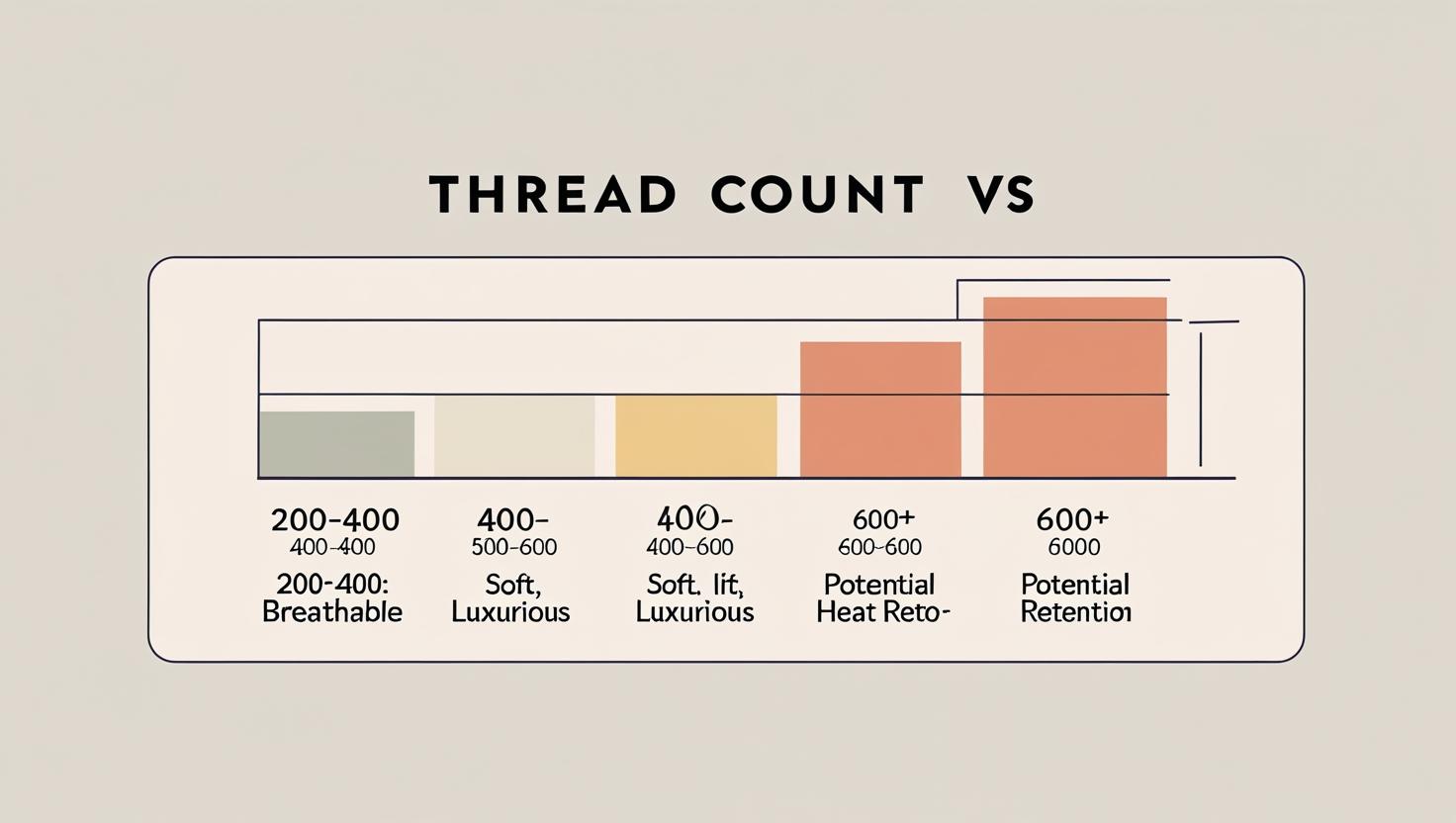
The Significance of Thread Count in Bedding Quality
Thread count plays a role in how your sheets feel and perform, but it interacts with other factors like fiber type, weave structure, and finishing techniques. Here’s how to evaluate its real impact. For a related read, don’t miss our article on cooling sheets for hot sleepers.
Softness and Feel
Softness isn’t just about numbers. A thread count of 300–500 made from high-quality long staple cotton—like Egyptian or Supima—delivers a silky, breathable finish. Go much higher, and you might sacrifice comfort for density. Sheets above 600 often use multi-ply yarns, which feel bulkier and less breathable.
Ever stayed in a luxury hotel and wondered why their sheets feel perfect? It’s likely because they use quality fibers in the optimal thread count range. Brands like Brooklinen and Parachute Home also use this principle—premium cotton and the sweet spot of 300–500. According to the Sleep Foundation, sheets within this range tend to balance comfort and durability best.
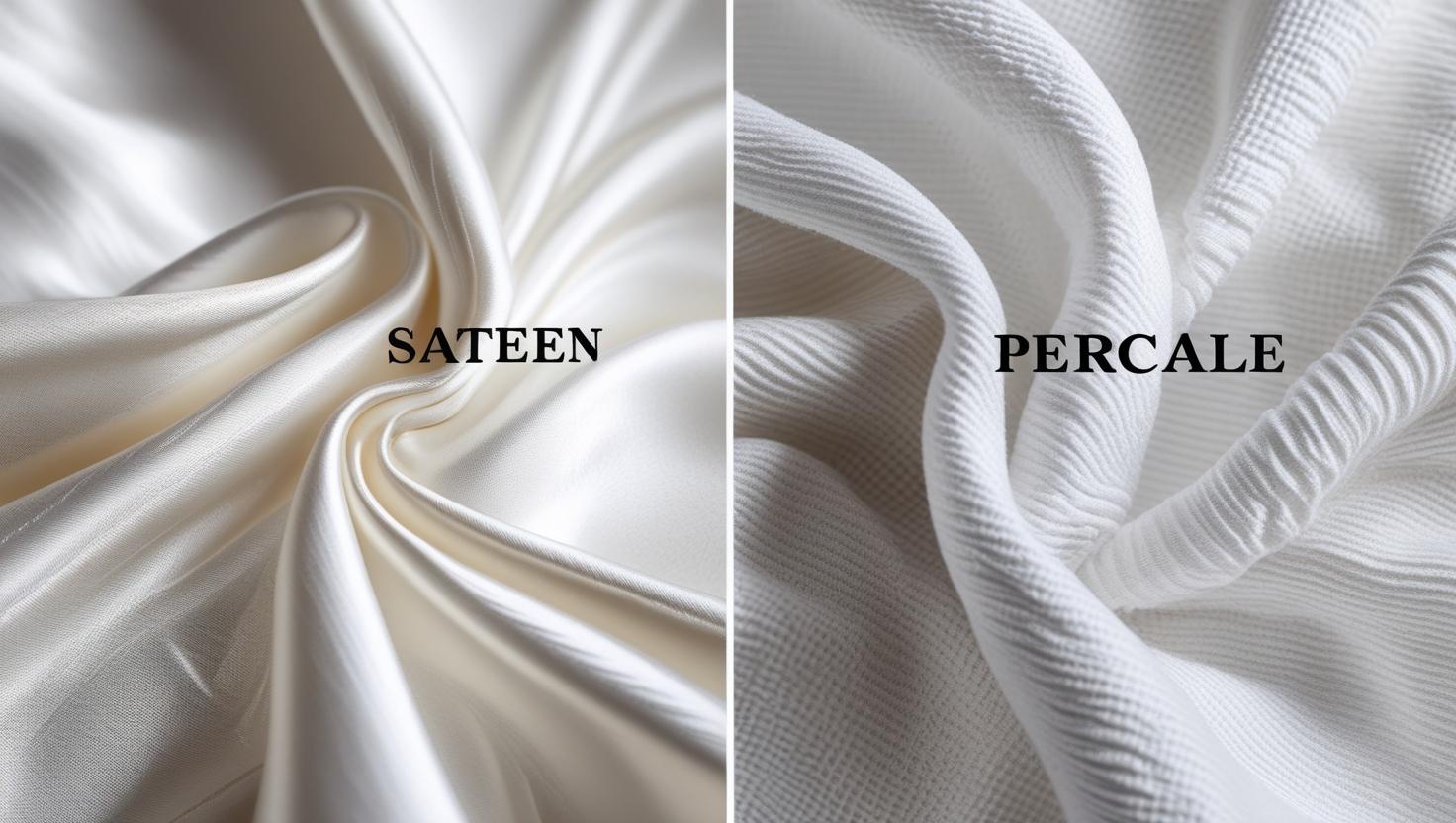
Durability
Durability comes down to fiber strength and weave tightness. Long-staple cotton fibers resist pilling, fraying, and tearing far better than short-staple cotton. Even at a 250 thread count, good cotton can outlast a cheap 800 count sheet. This is why investment-grade bedding often lists fiber origin up front.
Want your bedroom setup to last? Pairing high-quality sheets with a sustainable wood bed frame can enhance durability and eco-conscious living.
Breathability and Temperature Control
Overheating at night? Ultra-high thread count sheets can be the culprit. More threads often mean denser weaves, trapping body heat and moisture. For cool sleepers or summer nights, a 300–400 thread count in percale or bamboo viscose offers a cool, dry feel. It’s like flipping to the cool side of the pillow—every night. Learn more in our guide on bamboo vs. cotton sheets.
For comparison: a 300 thread count bamboo sheet breathes like linen but feels like silk, making it a top choice for hot climates or night sweats.
Weave Type
The type of weave changes the game. Sateen, with its tight one-yarn-under and three-yarn-over pattern, creates a luminous sheen and drapes beautifully. It feels luxurious, but can retain more heat. Percale, by contrast, uses a balanced one-over-one-under weave for a matte finish and crisp feel, ideal for warmer temperatures or minimalist preferences.
Think of sateen as your cozy winter sweater, and percale as your breathable summer T-shirt.
Marketing Gimmicks
Don’t fall for inflated thread counts. Some brands twist low-quality fibers into multi-ply yarns to artificially inflate the number—an 800 thread count that’s actually four 200-thread plies. This doesn’t improve comfort or durability; in fact, it can do the opposite. Stick with single-ply yarns and trusted certifications.
When in doubt, look for transparency in labeling and avoid buzzwords without substance. The Consumer Reports guide on thread count is a helpful resource.
Ideal Thread Count by Material
Different fabrics perform best at different thread counts. Here’s a quick-reference guide to help you choose:
| Material | Ideal Thread Count |
|---|---|
| Egyptian Cotton | 300–500 |
| Pima Cotton | 200–400 |
| Bamboo Viscose | 250–400 |
| Linen | 80–140 |
| Microfiber (Synthetic) | 200–300 |
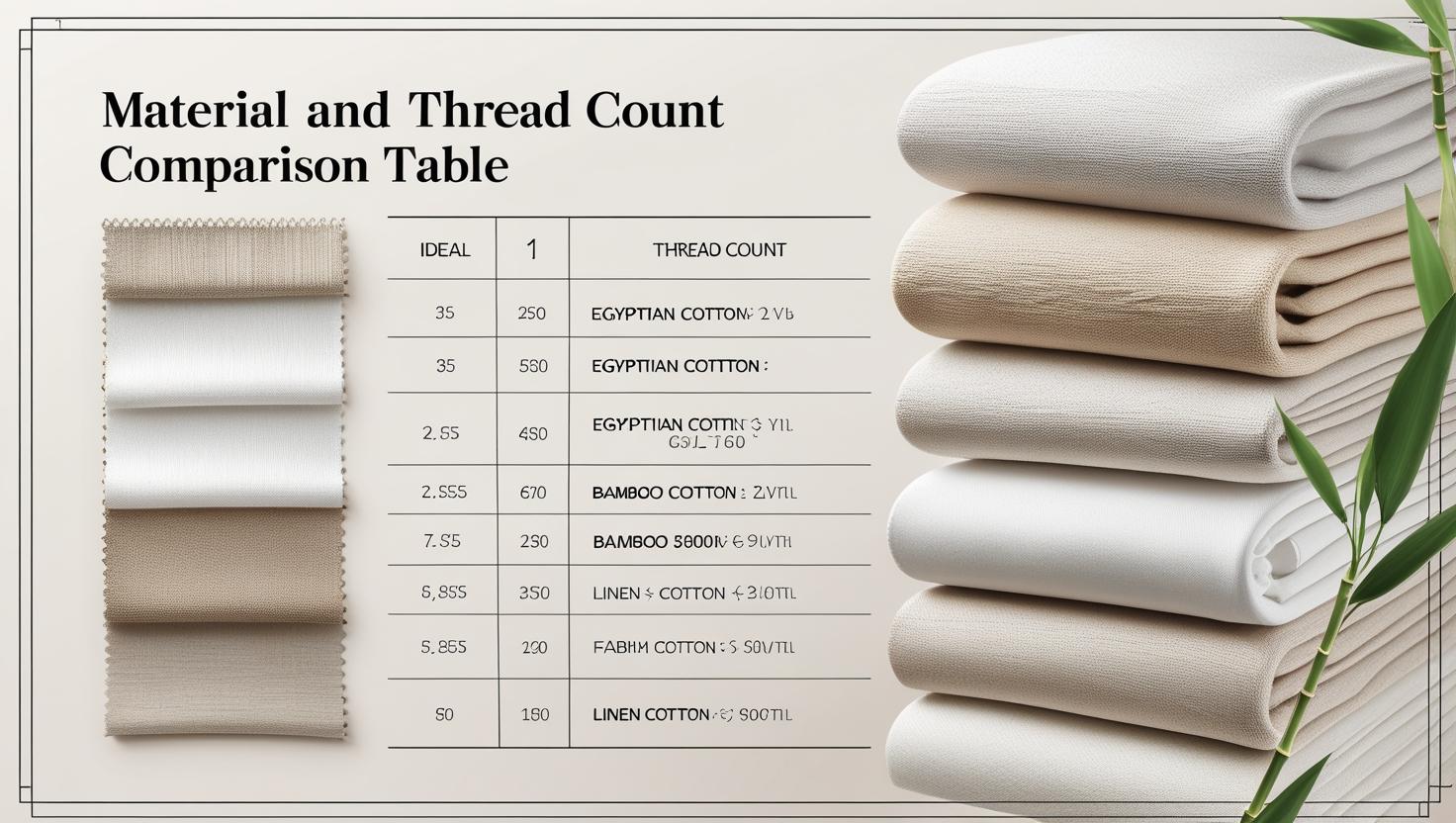
How to Choose High-Quality Bedding
Don’t let thread count be your only guide. The best bedding choices come from a holistic view of materials, manufacturing, and personal needs. For more insight, visit our guide on choosing the right bed sheets.
- Fiber Origin: Look for extra-long staple (ELS) cotton like Egyptian or Supima for unmatched softness and longevity.
- Certifications: OEKO-TEX ensures the sheets are free from harmful chemicals, while GOTS covers organic integrity and sustainability. These labels mean you’re getting a safe, ethical product.
- Weave Preference: If you run hot, go for crisp percale. Want cozy luxury? Sateen’s your friend.
- Finish and Stitching: Inspect for double-stitched hems and clean, tight seams—a sign of craftsmanship that lasts through washes.
Thinking beyond thread count? Discover how cardboard bed frames are reshaping the idea of sustainable living.
Some Common Thread Count Myths You Should Not Believe
- Myth: “Higher is always better.”
Truth: After 600, benefits plateau or even decline. More isn’t always more. - Myth: “Thread count is the only factor in comfort.”
Truth: Comfort relies just as much on fiber type, weave, and finish. Focus on feel, not just figures.
Understanding these myths helps you shop smarter and get better value for your money. Informed buyers sleep better—literally!
Final Thoughts
Understanding bedding quality thread count helps you make better choices. Don’t be misled by inflated numbers or clever marketing. Instead, look at the big picture: fiber quality, weave, certifications, and construction. When you shop with care, you’ll end up with sheets that feel better, last longer, and help you sleep soundly. And if you’re wondering about the environmental impact of your choices, check out our article on organic vs. synthetic bedding.
For a comprehensive overview of sustainable bedroom design, check out this article from The Roundup.
Looking for durability and eco-conscious choices? See what experts recommend in this piece from BigBeds.com.
Explore this insightful blog on Yawnder.com to learn how to find the right eco-friendly frame for your needs.
FAQ
- Is a higher thread count always better?
- No. Thread counts above 600 often do not improve comfort and may reduce breathability due to denser weaves that trap heat.
- What’s the best thread count for hot sleepers?
- Look for bamboo viscose or percale cotton sheets with a 300–400 thread count for optimal airflow and cooling comfort.
- What materials feel softest at lower thread counts?
- Egyptian and Pima cotton feel luxuriously soft even at 300 thread count due to their long staple fibers and smooth finish.
Related Reading from Cozy Bed Quarters
- Your Ultimate Guide on How to Clean a Bed Mattress
- How to Clean Stains Out of a Mattress
- How to Choose the Right Bed Sheets
Other Reading We Found Popular
Choosing Pillows for Comfort: 7 Expert Tips for Better Sleep
Choosing Pillows for Comfort and Better Sleep
When it comes to choosing pillows for comfort, the right pick keeps your head, neck, and spine aligned so you wake up refreshed instead of stiff. In this guide, you’ll learn how to match materials, loft, and features to your sleep style, plus how to spot quality so your pillow supports you night after night.
Key Takeaways: choosing pillows for comfort
- Match loft and firmness to sleep position. Side sleepers typically need higher, firmer loft; back sleepers do best with medium; stomach sleepers need the thinnest support.
- Material = feel + support + care. Memory foam contours, latex is buoyant and breathable, down is plush, and down alternative is hypoallergenic and easy-care.
- Prioritize alignment first. The best results when choosing pillows for comfort come from keeping ears, shoulders, and hips in a straight line.
- Look for adjustability and cooling if you toss or sleep hot. Shredded foam, removable inserts, and cooling covers help fine-tune comfort.
- Quality shows in construction and certifications. Seek reputable labels (e.g., CertiPUR-US®, GOTS, GOLS, OEKO-TEX®) and durable stitching.
The Importance of Support in Pillow Selection
Answer first: Proper support keeps your spine neutral so muscles can relax and heal overnight.
At its core, choosing pillows for comfort means finding a height and firmness that cradles your head without letting it tilt. A neutral neck reduces morning aches and headaches and can even lessen snoring by helping your airway stay open.
Answer first: Replace pillows when they flatten, fold, or feel lumpy.
If you’re constantly scrunching for extra loft or notice flat spots, it’s time to retire that pillow. Most pillows last 1–2 years; premium latex or high-density foams can last longer with care.
Answer first: Simple care extends comfort and lifespan.
Use a breathable protector and wash pillowcases weekly. Fluff down/alternatives, and follow manufacturer care for foam or latex. For bedding add-ons that amplify comfort, see our bed accessories guide.
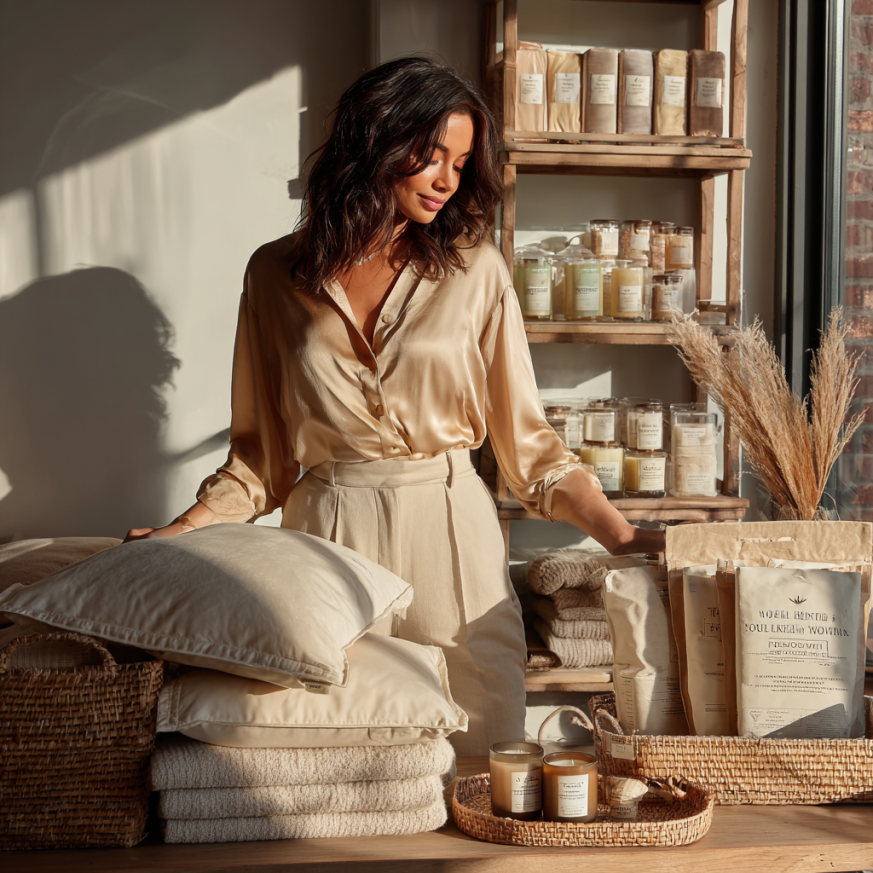
Popular Pillow Materials and What They Feel Like
Answer first: Your fill dictates feel, temperature, and upkeep.
Materials matter when you’re choosing pillows for comfort. Each fill has a distinct balance of contour, bounce, breathability, and maintenance.
Memory Foam
Fast take: Contouring support that relieves pressure for side and back sleepers. Solid foam feels uniform; shredded foam is more moldable and adjustable. If you sleep warm, look for ventilated cores or cooling covers.
Latex
Fast take: Naturally buoyant and breathable with a subtle spring. Latex resists dust mites and tends to outlast many foams. If sustainability is a priority while choosing pillows for comfort, consider organic or GOLS-certified latex and pair it with eco-conscious bedding.
Down
Fast take: Cloud-soft, ultra-plush feel that’s lightweight and breathable. Down requires regular fluffing to maintain loft and may not provide enough lift for broader shoulders.
Down Alternative
Fast take: Hypoallergenic and easy-care with a soft, down-like feel. Great for guest rooms or anyone sensitive to natural down.
Want a quick external overview of pillow types and picks? Explore the Sleep Foundation’s best pillows, Parachute’s pillow guide, and the Better Homes & Gardens buying guide for independent testing and buying tips.

Choosing Pillows for Comfort by Sleep Position
Answer first: Align your head with your spine, then let position guide loft and firmness.
Different positions need different heights. Here’s how to dial it in while choosing pillows for comfort.
Side Sleepers
Fast take: Choose a higher, firmer loft that fills the shoulder-to-neck gap and keeps your head from dipping. Consider gusseted designs that maintain edge-to-edge height.
Back Sleepers
Fast take: Medium loft supports the natural neck curve without pushing your head forward. A slight contour can reduce snoring and morning stiffness.
Stomach Sleepers
Fast take: Go thin and soft—or skip a pillow—to avoid neck extension. A low-loft down or down-alt can keep things comfy and neutral.
Combination Sleepers
Fast take: Adjustable or shredded-foam pillows let you fine-tune height. If you often overheat, add a breathable cover and consider lighter fills. For fabric choices that feel cool and dry, see our guide to best bedding materials for hot sleepers.

Additional Features to Consider
Answer first: Cooling tech, removable fills, and breathable covers personalize comfort.
If you run warm, look for gel-infused or ventilated cores and moisture-wicking covers. Bamboo-viscose, cotton percale, and TENCEL™ lyocell are common cool-sleep fabrics.
Adjustability
Fast take: Removable inserts or zippered shredded foam help you tune loft over time—especially helpful if your mattress feel changes or you’re refining your setup while choosing pillows for comfort.
Breathable, Washable Covers
Fast take: A removable cover makes maintenance easier and can drastically improve temperature regulation.
Sustainability
Fast take: Prefer organic cotton shells, responsibly sourced down, or natural latex. For bedroom upgrades that feel good and look beautiful, browse mirrors and wall decor to build a restful sanctuary.
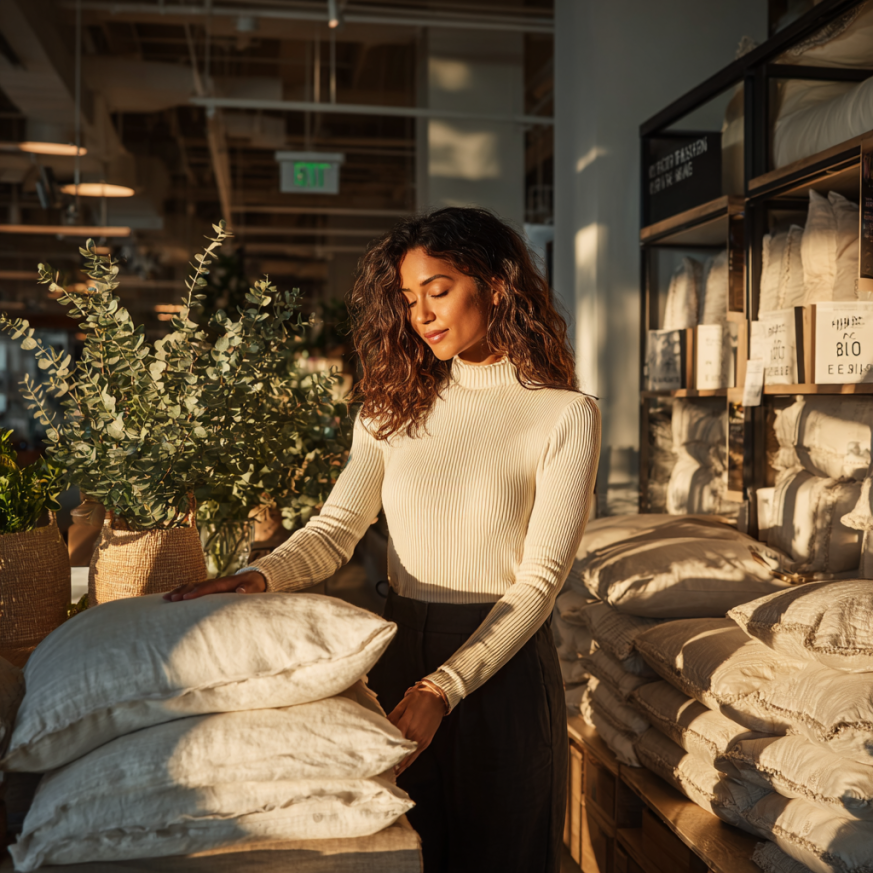
Proper Alignment for Better Sleep
Answer first: Think ears over shoulders—your pillow should hold you there comfortably.
Too-high pillows bend your neck forward; too-flat pillows drop your head back. The sweet spot keeps your nose pointed straight up, not tilted.
Supportive Add-Ons
Fast take: A knee pillow for side sleepers or a small lumbar pillow for back sleepers keeps the rest of your spine in line. Looking to top off your mattress for extra pressure relief while choosing pillows for comfort? See our picks for the right mattress toppers.
Hygiene & Longevity
Fast take: Use a zippered protector to shield from sweat and allergens, and wash it regularly. Replace pillows at signs of persistent flattening or odor.
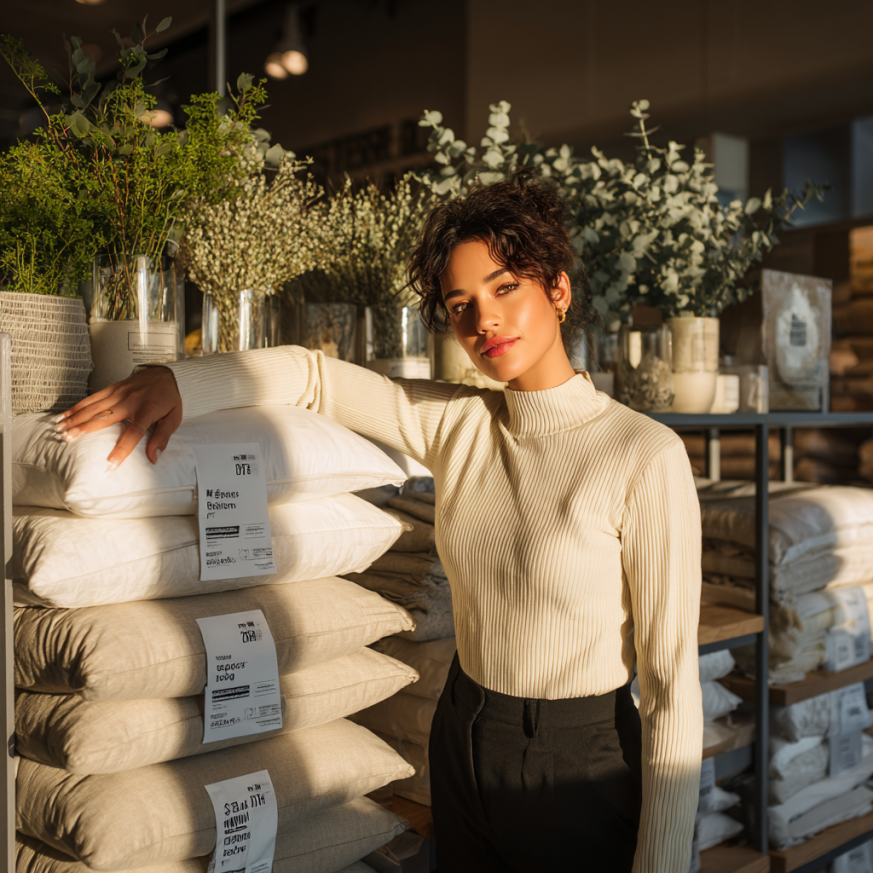
Customizing Your Pillow
Answer first: Adjustable designs solve most fit issues with simple at-home tweaks.
Shredded foam and modular inserts let you remove or add fill until your head rests just right. For couples, adjustable pillows make it easy for each partner to personalize support while choosing pillows for comfort.
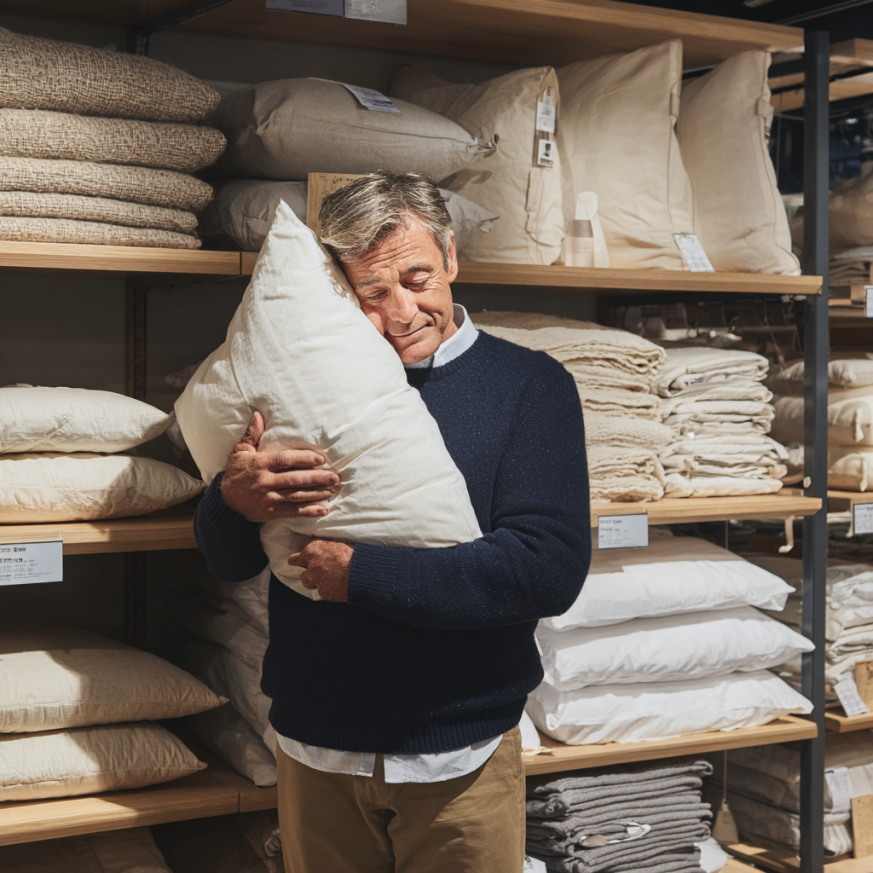
Investing in Quality for Long-Term Comfort
Answer first: Durable materials and tight stitching keep pillows comfy for years.
Premium latex and high-density foam resist early sagging, and double-stitched seams reduce seam stress. Pair your pillow with breathable sheets and a supportive topper to elevate your whole setup while choosing pillows for comfort. For ideas, visit our bed accessories guide.
Buyer’s Guide: Certifications & What They Mean
Answer first: Labels verify safety and sourcing—use them to compare options quickly.
- CertiPUR-US® (foam): Ensures polyurethane foam is made without certain harmful chemicals and meets emissions standards.
- OEKO-TEX® STANDARD 100 (fabrics): Tests textiles for substances of concern at every stage of production.
- GOTS (organic cotton) & GOLS (organic latex): Verify organic status and responsible processing from farm to finished product.
- Responsible Down Standard (RDS): Confirms animal-welfare practices for down sourcing.
For more perspective as you’re choosing pillows for comfort, compare expert testing from the Sleep Foundation, materials breakdowns from Parachute, and hands-on picks from Better Homes & Gardens.
Eco-Friendly vs. Conventional Pillows
Answer first: Eco options can reduce chemicals and waste without sacrificing comfort.
Natural latex and organic cotton shells often offer low-odor performance and traceable sourcing. Conventional options can still be great—just lean on certifications and solid construction while choosing pillows for comfort.
| Category | Eco-Friendly Examples | Conventional Examples |
|---|---|---|
| Core Materials | Organic latex, organic cotton fill, responsibly sourced down | Polyurethane memory foam, polyester down-alternative |
| Pros | Lower VOCs; traceable supply chains; biodegradable components | Lower cost; wide availability; consistent feel options |
| Considerations | Higher upfront price; firmer feel (latex) | Potential for higher heat retention or odors if uncertified |
If you’re refreshing your whole space while choosing pillows for comfort, explore eco-conscious bedding to build a healthier sleep setup.
FAQ
- What should I prioritize when choosing pillows for comfort?
- Start with alignment: pick a loft that keeps your neck neutral, then choose the material that matches your feel preference and temperature needs.
- Which material is best for neck pain?
- Memory foam and ergonomic latex pillows provide targeted contouring that supports the cervical curve and reduces pressure points.
- Do stomach sleepers need a pillow?
- Many prefer a very thin, soft pillow—or none—to avoid neck extension. A thin knee pillow can also ease lower-back strain.
- How often should pillows be replaced?
- Plan on every 1–2 years for most fills; high-quality latex or dense foams can last longer. Replace sooner if your pillow feels flat, lumpy, or causes stiffness.
- Are cooling pillows worth it?
- If you sleep warm, yes. Look for breathable covers, ventilated cores, or phase-change fabrics to help regulate temperature while you’re choosing pillows for comfort.
Final Thoughts
Great sleep starts with alignment, and that’s why choosing pillows for comfort is a small decision with big rewards. Use this guide to match loft, materials, and features to your body—and lean on Cozy Bed Quarters resources whenever you want expert, friendly help.
Related Reading
From Cozy Bed Quarters
- Choosing Pillows for Comfort: 7 Expert Tips for Better Sleep
- Sustainable Bedding Brands: Game-Changing Picks
- Eco-Friendly Bedding Choices: Sustainable and Comfortable
Helpful External Guides
Fitted vs Flat Sheets: What’s Best for Your Bed?
Fitted Sheet vs Flat Sheet (Deep Pocket): Choosing the Best Bedding
Choosing between a fitted sheet, flat sheet, and deep pocket sheet set can make or break your sleep comfort. Understand the differences and find the ideal bedding setup for your mattress and sleep style.
Key Takeaways: Fitted vs Flat Sheets
- Fitted sheets hug your mattress base with elasticized corners, keeping the sheet secure throughout the night—ideal if you toss and turn or share your bed with a partner or pets.
- Flat sheets sit loosely on top of the mattress and beneath your blanket or duvet, offering flexible layering and ease of laundry between heavier bedding washes.
- Deep pocket sheet sets cater to thick or pillow‑top mattresses and prevent frustrating corner slip‑offs. These sets typically include coordinating flat sheets and pillowcases for a polished look.
Check out our pillar post on luxurious sheets for premium ideas, and our guides from cotton to silk materials and thread‑count impact.
What Is a Fitted vs Flat Sheet—and What Are Deep Pocket Sheets?
Fitted, flat, and deep pocket sheets offer different fit and functionality—each best suited for specific mattress types and sleep styles.
A fitted sheet is designed with elasticized corners that wrap snugly around the mattress—ideal for staying in place. A flat sheet is a simple rectangle of fabric placed between you and the duvet or top layer. A deep pocket sheet set usually includes a fitted sheet with taller elastic walls (typically 16″ to 22″) and matching flat sheet and pillowcases, crafted to fit deeper modern mattresses.
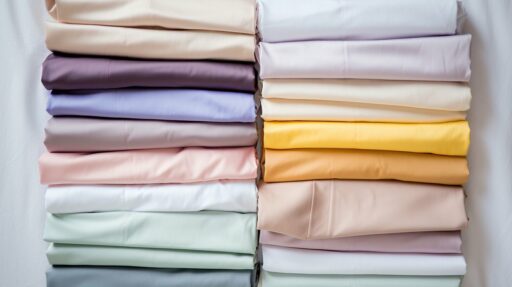
Top Benefits of Each Sheet Style
1. Fitted Sheets
Fitted sheets provide secure fit and stability throughout the night.
- Secure Fit: Elastic corners prevent shifting, especially on adjustable or shared beds.
- Easy Making: Simple to put on and take off when laundering.
- Streamlined Look: Gives a tidy, hotel‑style finish to your bed.
2. Flat Sheets
Flat sheets offer layering flexibility and breathable separation from your duvet.
- Layer Control: Adds a breathable layer between duvet and sleeper, easier to wash than heavier bedding.
- Flexible Use: Can double as a light blanket in warm months or be tucked in for a crisp finish.
- Versatile Fit: One size can fit many mattress depths if layered with fitted sheets.
3. Deep Pocket Sheet Sets
Deep pocket sets ensure a snug fit for very thick mattresses while offering coordinated bedding.
- Perfect for Thick Mattresses: Designed to hug deep or pillow‑top bed bases without slipping off.
- Coordinated Style: Includes flat sheet and pillowcases in matching fabric for a polished look.
- Material Variety: Available in cotton, bamboo, TENCEL, and blends—great for comfort and breathability.
How to Choose the Right Sheet Style for You
Choosing the right sheet style depends on mattress depth, comfort needs, and laundering habits.
- Measure your mattress depth (standard ~10″, deep pocket 14″‑22″).
- Identify your bedtime routines: do you need staying power (choose fitted) or layering (flat)?
- Select material based on comfort and season: cotton for breathability, TENCEL or bamboo for moisture-wicking.
- Consider laundering ease: fitted sheets are quicker to strip, while coordinating sets offer matching aesthetics.
- Check upgrade options like cooling fabrics or additional pillowcases when choosing sets.
For more guidance on fabric and thread‑count choices, check helpful editorial advice at Apartment Therapy, Ethical Bedding, Dzee Home, Beddy’s, Healthy House on the Block, and Our Sleep Guide.
Best Options Compared
| Style | Fit & Use | Material Options | Best For |
|---|---|---|---|
| Fitted Sheet | Elastic corners, tight fit | Cotton, linen, bamboo | Standard mattress, minimal shifting |
| Flat Sheet | Loose, layerable | Same as fitted | Warm sleepers, layering, crisp tuck‑in |
| Deep Pocket Sheet Set | Deep elastic, full set included | Cotton sateen, TENCEL, bamboo blends | Thick mattresses, matching style |
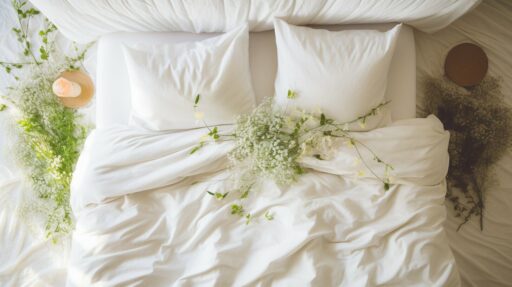
Quick Answer: Fitted vs Flat Sheets
If you want stability and easy use, go with a fitted sheet. Prefer versatility and layering? A flat sheet is great. Need both fit and a coordinated look for a thick mattress? Choose a deep pocket sheet set.
FAQ: Fitted vs Flat Sheets
- Are deep pocket sheets always necessary?
- Only if your mattress exceeds standard depth (typically over 12″). Deep pocket helps prevent corner slippage.
- Can I use a flat sheet without a fitted sheet?
- Yes—though the bed may lack structure. Flat sheets alone work best on lighter mattresses or as removable layers.
- How do I care for fitted and flat sheets?
- Wash according to fabric instructions (most cotton or bamboo sheets are machine‑washable) and avoid over‑drying to maintain elasticity.
- Does thread‑count matter?
- Yes—a thread‑count between 200–400 typically balances softness and breathability. Heavier thread‑counts may restrict airflow.
- Should I match pillowcases to sheets?
- Using matching pillowcases—or a full set—creates a cohesive look and ensures fabric consistency for comfort.
- Apartment Therapy article on bedding basics
- Healthy House on the Block cotton vs bamboo guide
- Our Sleep Guide mattress & sheet pairing tips
Enjoy this guide? Sign up for our newsletter to discover more ways to elevate your sleep sanctuary.
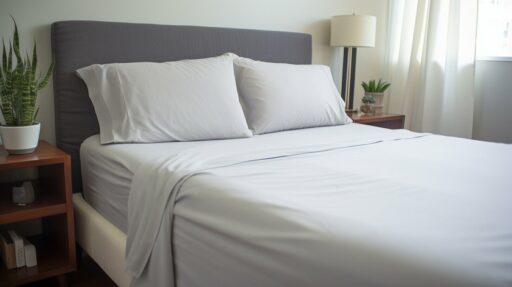
Best Bedding Material to Enhance Your Sleep
Best Bedding Materials to Enhance Your Sleep
Are you looking for the best bedding materials to enhance your sleep? Look no further! In this detailed guide, we’ll explore a wide range of bedding material options to help you make an informed choice that matches your comfort, style, and wellness needs.
Picking the right fabric can make a world of difference—not just in how cozy your bed feels, but in how rested you wake up. From breathable cotton to silky indulgence, every material has its own story, and we’re here to help you figure out which one’s perfect for you.
Key Takeaways:
- Choosing the right bedding material is essential for a comfortable, restful sleep experience.
- Cotton is known for elegance, versatility, and breathability, while silk offers luxury, beauty, and wellness benefits.
- Different weaves like percale and sateen affect cotton’s texture and warmth levels.
- Silk is hypoallergenic, regulates temperature, and is gentle on hair and skin but needs delicate care.
- Other bedding materials like bamboo-derived rayon, linen, flannel, polyester, microfiber, and Tencel each offer unique perks depending on your preferences and lifestyle.
The Elegance and Breathability of Cotton
Cotton has long been a go-to for cozy, high-quality bedding. Its natural fibers provide a luxurious softness while being durable enough to withstand years of washing and wear. With cotton, you get the best of both worlds: comfort and practicality.
Whether you’re curling up under crisp percale sheets or sinking into the silky-smooth finish of sateen, cotton adapts beautifully to your sleep habits. Did you know cotton’s breathability also helps regulate your body temperature, keeping you cool in the summer and warm in the winter? No wonder it’s a favorite in households worldwide.
Remember, the quality of cotton matters too—look for long-staple varieties like Egyptian or Pima for extra softness and durability. Plus, cotton is easy to maintain and pairs beautifully with layered bedding like quilts, throws, and duvets.
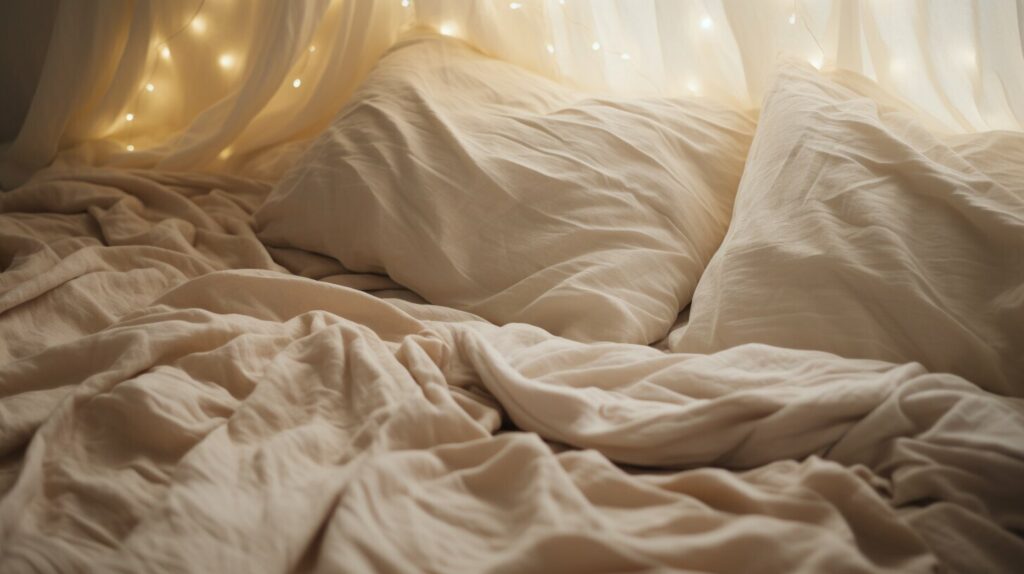
For more on cotton’s benefits, check out our post on bedding materials and benefits.
The Luxurious Beauty of Silk
Silk has long been a symbol of indulgence and sophistication. But beyond its beauty, silk offers several sleep-enhancing benefits. Its smooth surface minimizes friction on hair and skin, reducing tangles, wrinkles, or irritation.
Silk naturally repels dust mites and allergens, making it a great choice for sensitive sleepers. Unlike synthetic fabrics, silk regulates temperature beautifully—it keeps you cool when it’s hot and warm when it’s cold.
To maintain silk bedding, gentle care is key: use mild detergent, wash on delicate or hand wash, and air dry whenever possible. Investing in silk might feel luxurious, but many say it’s worth it for the comfort and health perks. Curious how it compares to cotton? Read more at Mulberry Park Silks.
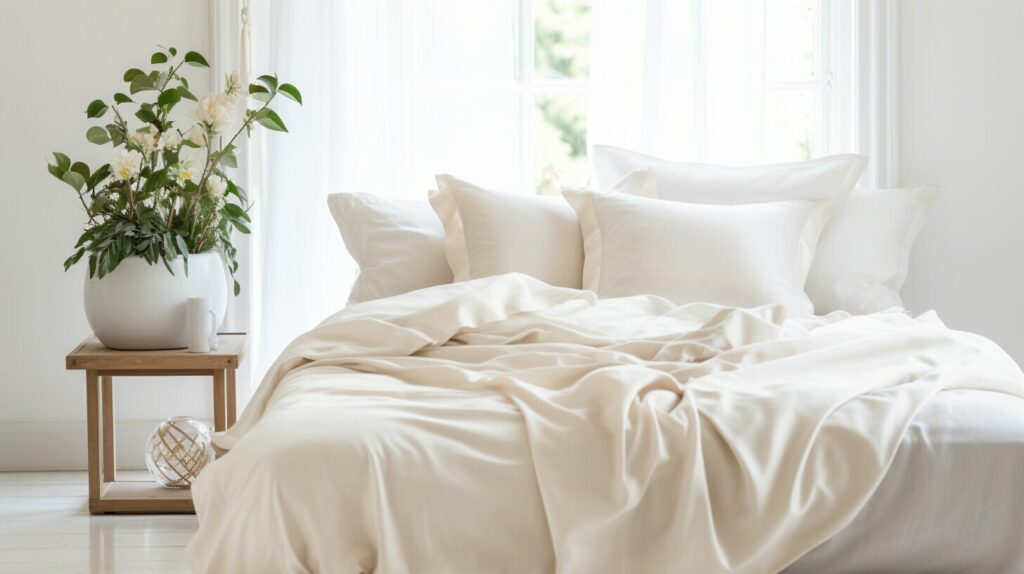
Eco-Friendly Bamboo-Derived Rayon
Bamboo-derived rayon is a favorite for eco-conscious shoppers. It starts with fast-growing bamboo, which needs no pesticides, making it sustainable. Once transformed into rayon, it becomes an ultra-soft, breathable fabric that feels cool to the touch.
Bamboo sheets are loved for moisture-wicking, keeping sweaty sleepers dry. They’re naturally antimicrobial, reducing odors and bacteria over time. If you care about the planet but want comfort, bamboo-derived rayon offers a perfect balance of sustainability and luxury.
Just follow care instructions to extend its lifespan. Whether paired with organic cotton or layered under a lightweight duvet, bamboo adds softness and peace of mind.

Rustic Charm with Linen
Linen bedding delivers rustic charm like no other. Woven from flax fibers, linen’s slightly textured feel softens dramatically over time. Its loose weave allows for incredible airflow, making it super breathable—perfect for warm sleepers or summer nights.
Though linen wrinkles easily, many embrace these soft crinkles as part of its cozy, lived-in look. Plus, it’s one of the most durable fabrics; with proper care, it can last decades.
Its hypoallergenic and moisture-wicking properties also make it smart for sensitive skin. Want to elevate your bedroom? Try mixing linen with cotton or layering linen throws for a textured, boutique look. Its earthy color palette can beautifully transform your space into a serene retreat.
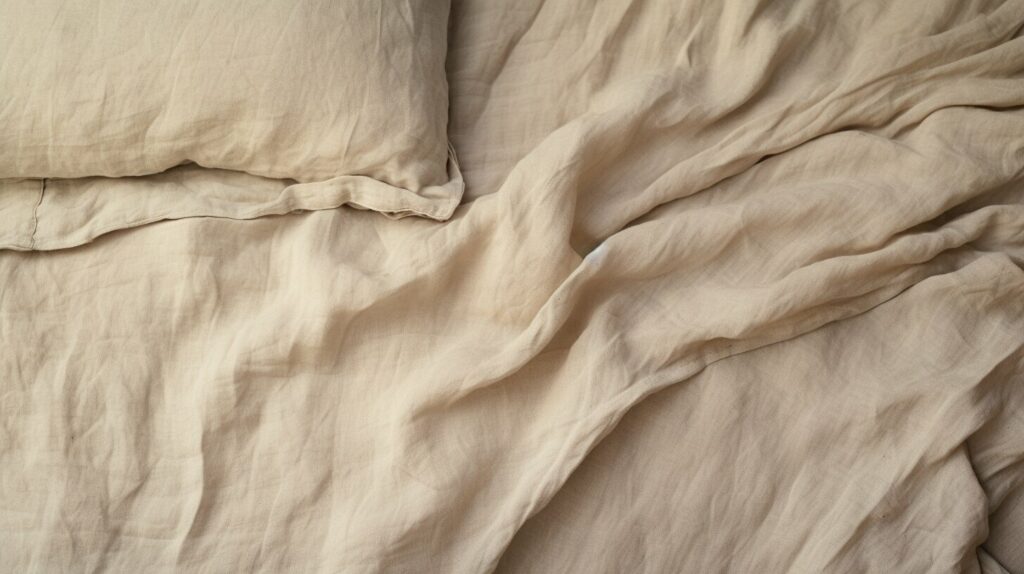
Warm and Snug with Flannel
When chilly weather rolls in, flannel sheets are the ultimate cozy companion. Made from cotton or wool, flannel’s brushed finish traps air and retains body heat, providing a comforting cocoon on cold nights.
Flannel is especially popular in long-winter regions, but it’s great for anyone who loves that warm, fuzzy feel year-round. High-quality flannel resists pilling and stays soft after many washes.
When shopping, check the weight—heavier flannel equals more warmth. Look for plaid or solid patterns to add nostalgic, cabin-like charm. To keep flannel fresh, wash on gentle and avoid high heat. Pair flannel sheets with a down comforter for an irresistibly toasty bed.
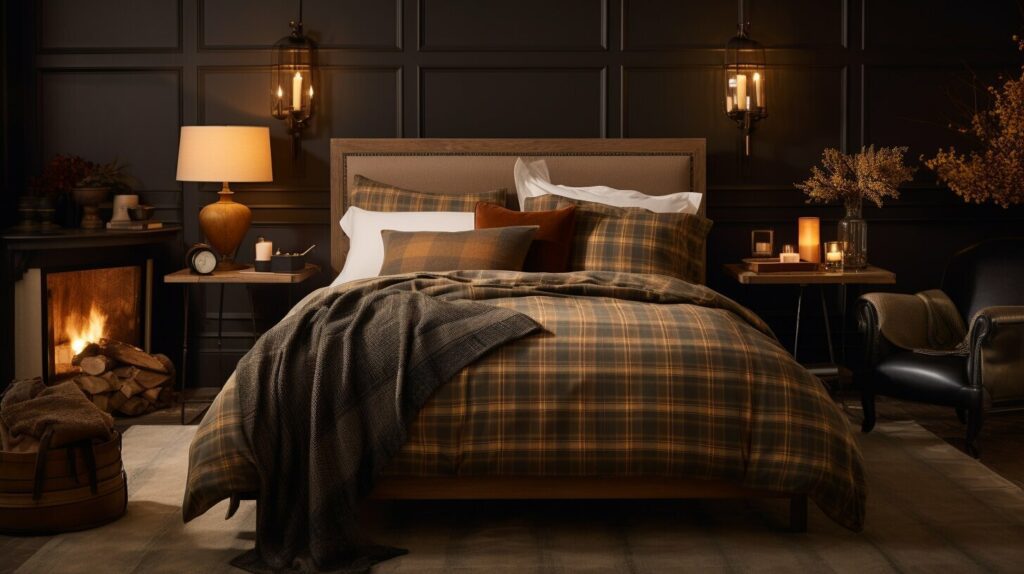
Affordable Options: Polyester and Microfiber
Looking for comfort on a budget? Polyester and microfiber sheets deliver soft, easy-care bedding at wallet-friendly prices. Polyester resists shrinking, stretching, and wrinkles, making it perfect for busy homes or guest rooms.
Microfiber, made from ultra-fine polyester strands, offers a plush, suede-like feel and is often hypoallergenic. These synthetics dry quickly, need minimal ironing, and hold up after many washes.
While they may not breathe as well as natural fibers, they excel in durability and price. Plus, they come in endless colors and patterns, letting you refresh your bedroom affordably. They’re great for kids’ rooms, vacation homes, or anyone needing easy-maintenance bedding.
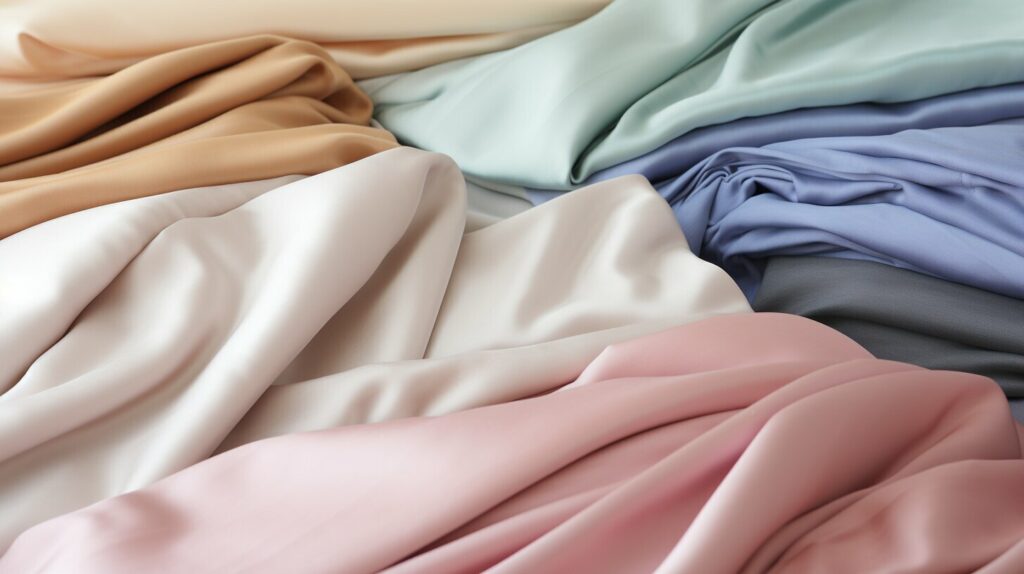
Sustainable Luxury with Tencel
Tencel, or lyocell, is a modern bedding material prized for silky softness and sustainability. Made from sustainably harvested wood pulp, Tencel production uses a closed-loop process that recycles water and solvents, minimizing environmental impact.
The result? A luxuriously smooth, breathable fabric that feels gentle on skin and regulates temperature beautifully. Tencel sheets are naturally hypoallergenic, making them great for sensitive sleepers. They resist wrinkles and shrinkage better than some natural fibers.
As Tencel gains popularity, it’s available in a variety of price points and styles, from minimalist solids to elegant patterns. For eco-minded shoppers wanting comfort and conscience, Tencel delivers. Pair it with organic cotton or bamboo for a fully sustainable sleep setup that’s kind to the planet and your skin.
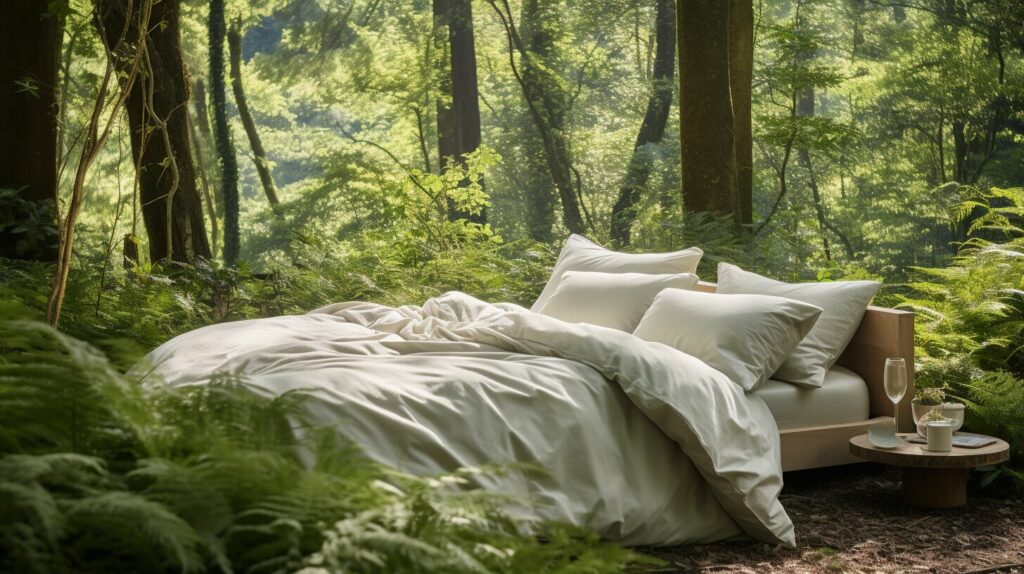
FAQ
What is the most breathable bedding material?
Cotton and linen are among the most breathable fabrics, perfect for hot sleepers or warm climates. Their natural fibers let air circulate, preventing heat buildup for cooler, more comfortable sleep.
Are silk sheets worth the investment?
Absolutely! While silk sheets can be expensive, they offer a luxurious feel, reduce friction on hair and skin, and are naturally hypoallergenic. Many people find the long-term comfort and beauty well worth the cost.
What’s the best bedding material for allergies?
Silk, bamboo-derived rayon, and Tencel are excellent hypoallergenic choices that resist dust mites, mold, and mildew. They help create a cleaner sleep space for sensitive skin or allergy sufferers.
How do I care for delicate bedding like silk?
Delicate fabrics like silk require special care: use a gentle detergent, wash on delicate or by hand, and air dry. Always follow the care label to maintain the beauty and longevity of your silk bedding.
Which bedding material lasts the longest?
High-quality cotton (like Egyptian or Pima) and linen are renowned for durability when properly cared for. With regular maintenance, these natural fibers can last for years, offering both comfort and value.
Nightstands: Stylish, Functional, and Modern Options for Every Bedroom
Nightstands Guide 2025: Styles, Storage, and Trends for Your Sleep Space
Nightstands are essential pieces of bedroom furniture that combine style, storage, and modern conveniences to elevate your sleep sanctuary and daily routine.
Key Takeaways
- Nightstands merge functionality and design to enhance both convenience and aesthetics.
- Drawers, shelves, and built-in charging ports help organize bedside essentials and reduce clutter.
- Nightstands contribute to bedroom decor and reflect personal style.
- Modern options include USB ports, power outlets, and space-saving features.
- Choosing the right height, size, and configuration ensures optimal comfort and balance.
The Multi‑Functional Power of Nightstands
Nightstands are much more than platforms for alarm clocks—they serve as storage hubs, design accents, and tech stations all in one. Whether you stash your phone, nighttime book, glasses, or a small lamp on them, nightstands elevate daily routines and contribute to a calming sleep environment.
Storage & Organization
One of the key benefits of nightstands is their ability to organize bedside essentials. Models featuring drawers and shelves let you tuck away items like cables, remotes, journals, or reading glasses. Full-extension metal side drawer guides and felt- or cedar-lined drawers not only enhance the drawer lifespan but also protect delicate items—just like offerings from Liberty Furniture.

Looking for clever storage ideas? See our guide on how to style and organize your bedside table.
Charging & Convenience
Tech-savvy nightstands now come equipped with built-in USB ports and power outlets, eliminating cord clutter and ensuring your devices stay charged overnight. This innovation reflects modern living—no more hunting for outlets or extension cords.
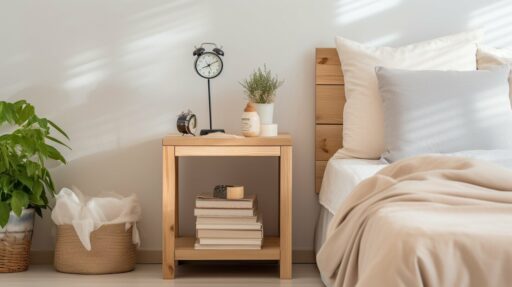
Health experts at the Sleep Foundation warn against evening screen time, but with a nightstand charging station you can unplug your phone while keeping it within reach—supporting better sleep hygiene.
Decor & Aesthetic Appeal
Nightstands play a pivotal role in bedroom aesthetics. They can echo your overall design theme—be it minimalist, mid-century modern, or farmhouse-chic. From sleek lacquer finishes to warm wood tones or metal frames, the styling potential is vast.
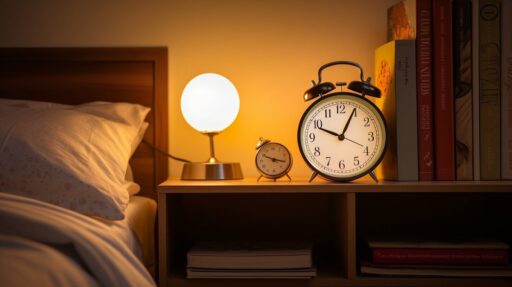
Add personality with decorative accessories: a vase, framed photo, or ambient lamp. These small touches can make a nightstand feel like a curated piece of art.
Styling Ideas
- Minimalist look: Opt for a slim, handle-less nightstand with concealed drawers and a matte finish.
- Rustic charm: Choose a reclaimed wood nightstand with raw edges and visible grain.
- Modern luxe: Glossy surfaces, metal legs, or mirrored finishes contribute to a glamorous vibe.
- Eclectic mix: Combine mismatched nightstands to add character and visual interest.
Explore more in our stylish nightstands and bedside tables guide or check out Architectural Digest’s best nightstands list.
Choosing the Right Nightstand
Selecting an ideal nightstand requires balancing size, height, and storage options. Here’s what to consider:
- Height: Should be level with or just below your mattress for easy reach.
- Width: 20–30 in wide works well for queen beds; adjust according to your nightstand’s depth and bedroom space.
- Storage Needs: Choose multiple drawers if you have many items, or open shelving for easy access to books or decor.
- Room Flow: Ensure enough clearance around the bed—nightstands shouldn’t block doors or pathways.
Practical Features to Look For
| Feature | Benefit |
|---|---|
| Built‑in USB/Power outlets | Charge phones, lamps, or tablets without extra adapters |
| Full-extension metal drawer glides | Smooth operation and full-access storage |
| Felt-lined top drawers | Protect jewelry, watches, glasses |
| Cedar-lined bottom drawers | Repels pests, keeps linens fresh |
| Mixed storage (drawers + shelves) | Balance concealed and display space |
For more on durable materials, visit our guide on best materials and designs for nightstands.
Health & Sleep Environment Benefits
Beyond practicality and appeal, a well-chosen nightstand supports your sleep environment. A decluttered area promotes relaxation and reduces visual stress. And positioning a soft-glow lamp within arm’s reach enables a calming bedtime routine.
According to the Mayo Clinic, maintaining an organized and comfortable bedroom fosters better sleep quality, and a supportive nightstand plays its part in that ecosystem.
Nightstands for Every Bedroom Type
Small or Compact Spaces
Slim or wall-mounted nightstands maximize floor space. A floating nightstand with a drawer and cable access hole is perfect beside twin beds or in studio apartments. Learn more about smart solutions in multi-functional nightstands for small bedrooms.
Large Master Suites
Go bold with matching double nightstands—opt for larger models that balance the scale of a king bed or include features like ambient lighting or touch-dimming lamps.
Shared or Kid’s Rooms
Durability is key. Choose nightstands made from solid hardwood or painted MDF with rounded edges. Multiple kids sharing a room benefit from stackable or modular storage options.
Maintenance Tips for Longevity
- Use coasters to prevent water stains from glasses.
- Dust weekly with a soft cloth; for wood, apply furniture oil monthly.
- Check drawer glides quarterly to ensure smooth movement.
- Protect surfaces with felt pads under lamps and gadgets.
Popular Nightstand Trends in 2025
As of mid 2025, trending nightstand styles include:
- Eco-friendly materials: Bamboo, recycled wood, and non-toxic finishes.
- Minimalist modular designs: Mix and match functional cubes and floating units.
- Hidden tech: Wireless charging pads and discreet USB ports behind panels.
- Mixed textures: Wood paired with matte metal or stone surfaces.
Explore more innovations in our modern bedside table trends feature or browse styles at Plank & Beam and Target’s nightstand collection.
Conclusion
Nightstands are essential pieces that enrich both function and form in your bedroom. By carefully choosing dimensions, storage types, and tech integration, you create a nightstand that complements your lifestyle—supporting rest, relaxation, and style. Embrace the impact of the perfect nightstand on your sleep sanctuary. For more insights, revisit our original feature on why nightstands matter.
FAQ
- What should I look for in a nightstand?
- Choose height that aligns with your mattress, storage capacity based on items, and quality materials. Built‑in charging adds a modern touch.
- Is a nightstand necessary?
- Yes—helpful for organizing bedtime items, keeping essentials nearby, and improving room aesthetics.
- How do I clean and maintain a nightstand?
- Dust weekly, use appropriate cleaners for wood or metal, and prevent stains by using coasters.
- What are current design trends?
- Eco materials, streamlined modular units, wireless charging, and mixing finishes are trending in 2025.
- Can I use two different nightstands?
- Absolutely—eclectic pairings can add visual interest, as long as both are similar in height and scale.
Related reading from Cozy Bed Quarters
- Stylish Nightstands and Bedside Tables Guide
- Best Materials & Designs for Durable Nightstands
- Modern Bedside Tables: Innovations & Trends
Other reading we found popular

